- About Emily
- About This Blog
- Personal Posts
- My Travel Stories
- Central America
- North America
- South America
- Tours and Activities
- Transport and Travel
- Packing Tips
- Travel Gear
- Travel Fashion and Beauty
- Work with me


Mountain Warehouse Backpack Review: Traveller 60 + 20L Rucksack
- Product Reviews
- Last Updated 11 April 2024
Some posts on this site contain affiliate links. If you book or buy something through these links, I earn a small commission (at no extra cost to you). Take a look at my privacy policy for more information.
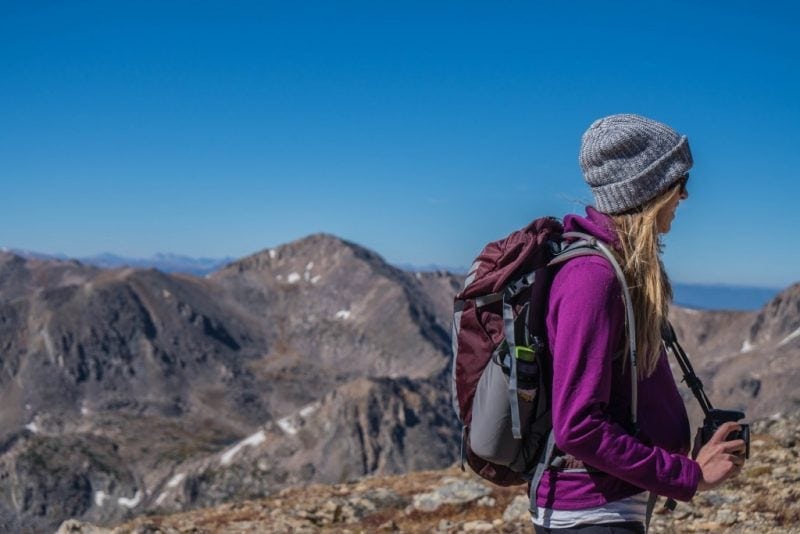
In this honest Mountain Warehouse backpack review, I’m sharing my love for my trusty Traveller 60+20-litre Rucksack.
This was my pack of choice for many years, and is still going strong despite being several years old. I genuinely think the Traveller 60+20-litre Rucksack is the perfect backpack for first-time travellers!
Choosing the right backpack for long term travel or a Round-the-World trip is a serious decision. Your backpack can be your best friend while you’re away – or your worst enemy. An uncomfortable, heavy or poorly made one could genuinely ruin your trip!
Before I left for my first backpacking trip several years ago, I did a ton of research. I also asked lots of other travellers in order to find the best backpack for me. Several years and multiple trips later, it’s still serving me brilliantly…
READ MORE: Best Backpacks for Female Travellers
Disclaimer – Mountain Warehouse sent me this bag free of charge in exchange for an honest review . I used it for YEARS and genuinely loved it!
Mountain Warehouse Backpack Review
This post is all about the Mountain Warehouse Traveller 60 + 20 Litre Rucksack. The pack has been around for several years, and remains one of the store’s most popular backpacks. Designed specifically with travellers in mind, rather than for use by hikers and campers, this pack is PERFECT for long term travel.
At around £60*, this is a really reasonably priced backpack and perfect for those whose budgets are tight.
Hopefully, this Mountain Warehouse backpack review will help you decide if the Traveller Rucksack is right for you…
* Check the latest prices HERE !
What Size Backpack do I Need?
Deciding on the right size was the hardest part of selecting my backpack. Lots of travellers I know travel light, with a carry-on sized backpack at 35L or less. It sounds fantastic in theory, but in practice, travelling with only hand luggage just doesn’t work for me.
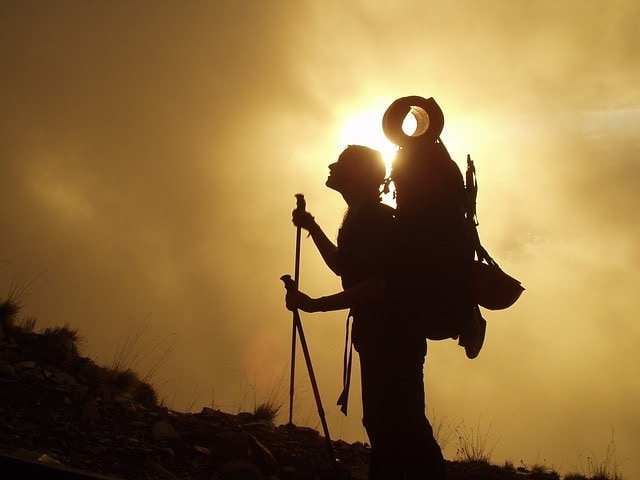
The best travel backpack size is around 50 to 60L. This should be large enough to carry everything you need, but not so big that it’ll make life impossible for you on the road! I settled on 60L, which has suited me fine over the years. It’s not carry-on sized, but it’s also not so big that I turn into a turtle. And I can fit everything I need for any trip length in a 60L backpack.
Mountain Warehouse Traveller 60 + 20 Litre Rucksack
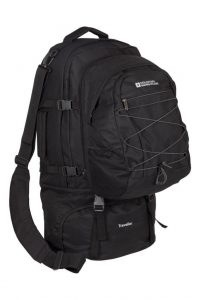
Capacity and Size
The traveller is a 60+20-litre rucksack. That means that the main bag has a 60L capacity, but also comes with a detachable 20L day-pack. In total, you have the option of 80L storage space.
I rarely use both bags together, because a whole 80L of stuff on my back turns me into a snail! But it’s nice to be able to attach them together when I’m checking the luggage in for a flight. The day-pack can also be clipped on to the straps so that it can be carried on the front if needed. “Double-turtling” is a great way to even out the load!
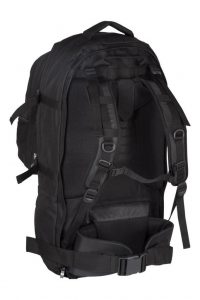
What I love about the Mountain Warehouse Traveller Rucksack is the comfy hip belt and the adjustable, padded shoulder straps, which mean that the bag fits me perfectly and the weight is spread across my whole body. It’s a surprisingly comfy backpack – as long as you’re sensible about weight distribution and don’t fill it with more than you’re capable of carrying (something I learnt the hard way).
Unzips all the Way Round!
But here’s what makes the Mountain Warehouse Traveller 60 + 20 Litre Rucksack the perfect backpack for long travel. It unzips all the way around, instead of opening just at the top.
Sounds like a small detail, but it’s one that makes a huge difference. Remember that sinking feeling when you realise that what you need is right at the bottom of your backpack? Not any more! A bag that opens all the way around, suitcase-style, is a backpacker’s best friend and genuinely makes life so much easier on the road.
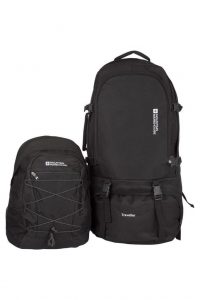
Other Awesome Features
Another great feature is the free rain-cover, tucked away into one of the many pockets the Mountain Warehouse Traveller Rucksack has to offer.
Shockingly enough, rain isn’t a phenomenon exclusive to England, and wherever you travel on your RTW trip you’re bound to encounter a downpour at least once. The rain-cover has come in handy time and again, not just when it rains but also as a handy protector for the outside of my backpack when it’s in the hold of a bus on long journeys.
As I said, there are plenty of pockets, plus a separate zipped compartment at the bottom of the bag.
Better yet, there’s a zippable cover that tucks all the straps neatly out of sight, for ease when checking the bag in for a flight. Airlines usually ask you to tighten and tuck in all the straps when you check in a bag – which can ruin your perfectly-set-up strap adjustments – so being able to zip them all away ready to fly is a fantastic option.
Mountain Warehouse Backpack Review – an Update
The Mountain Warehouse Traveller 60 + 20 Litre Rucksack is seriously durable. It’s had to be, to keep up with me as I’ve lugged it all over the world.
My backpack has been dragged up steps and thrown onto buses, kicked under dorm beds and dropped, squashed, and taken out into all weathers from dry desert heat to jungle humidity. It’s even served as a seat MANY times. After 7 years of use (as of 2021), I really am happy to recommend this fabulous backpack as the perfect choice for long-term travellers with a lot of stuff to carry.
I hope this Mountain Warehouse backpack review helped! If you have any questions about the Traveller 60 + 20 Litre Rucksack, scroll down to leave a comment.
Related Posts
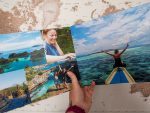
Bob Books Travel Photo Book Review – AND 15% Discount Code
- Last Updated 1 August 2024
A review of the photobooks from Bob Books. How good are they and are they worth the money? PLUS get 15 % off with my Bob Books discount code!
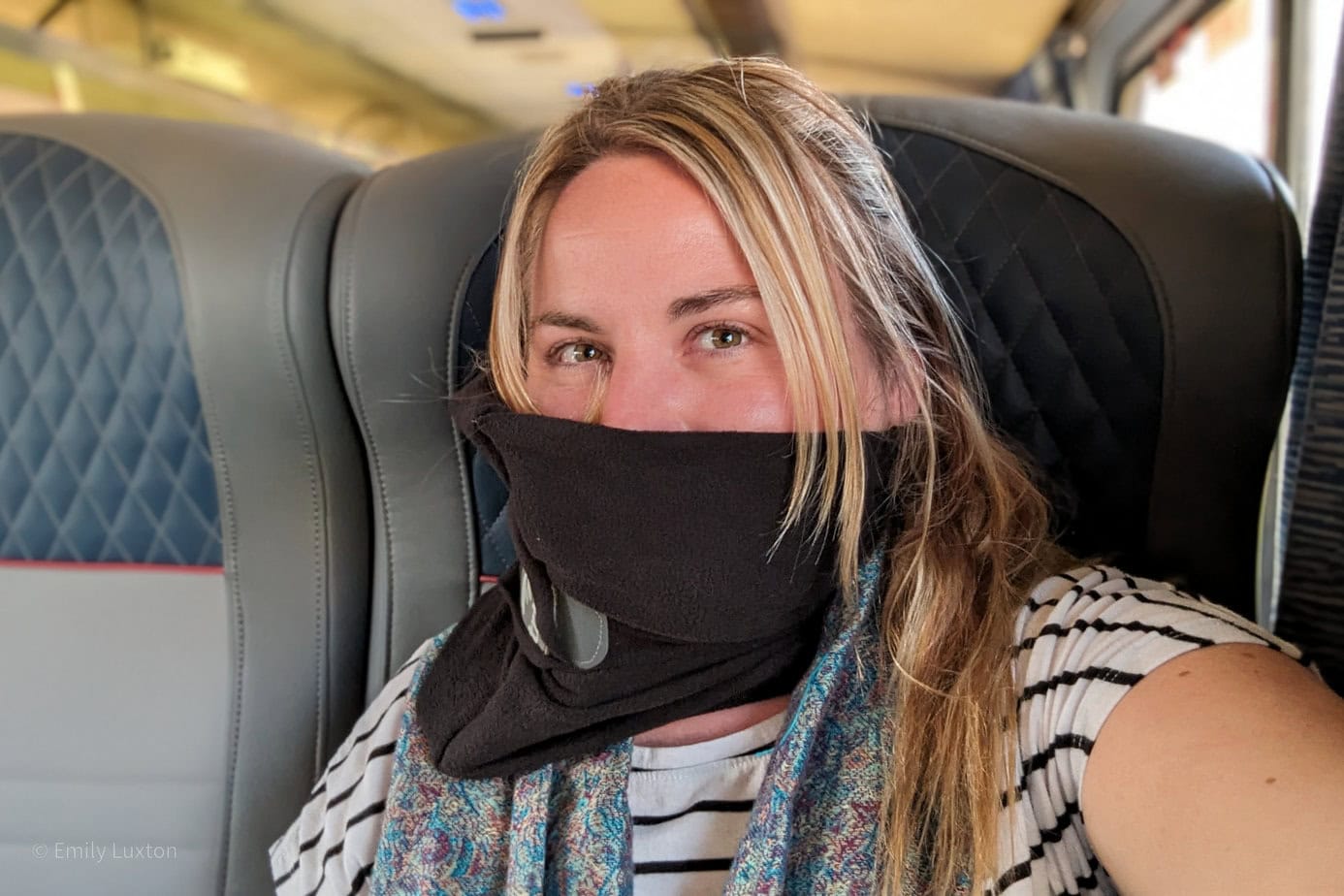
TRTL Travel Pillow Review: Is it Worth the Hype?!
- Last Updated 26 June 2024
My honest review of the insta-famous TRTL Travel Pillow: does this wrap-around pillow really work as well as promised?
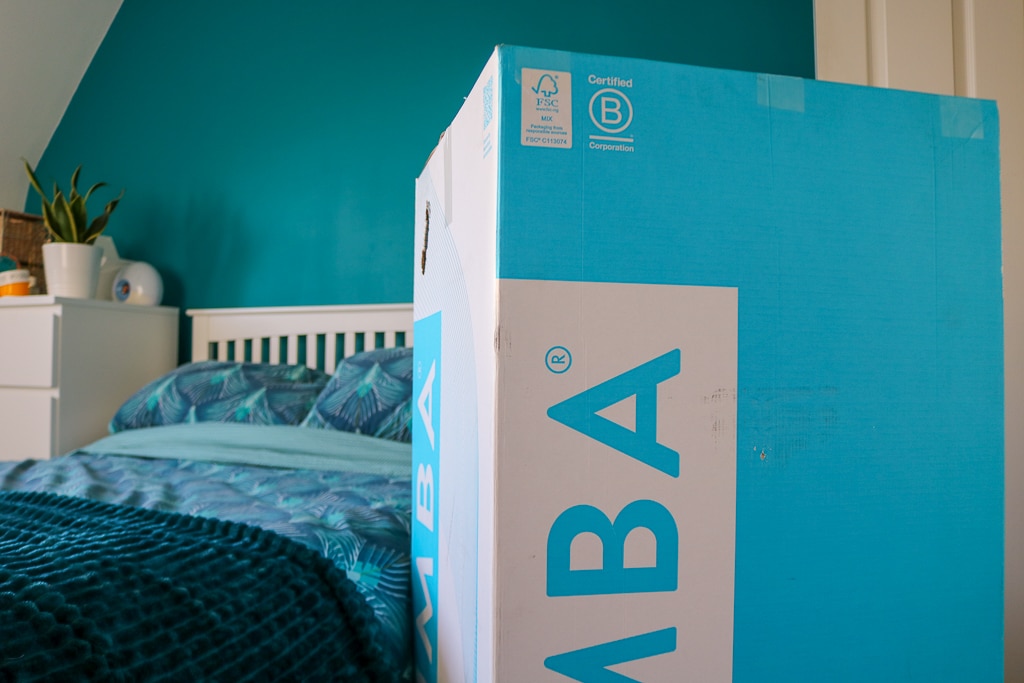
Review: Is a Simba Hybrid Mattress Really Any Good?
- Last Updated 29 March 2024
An in-depth review of the Simba Hybrid ® Original Mattress: what is it, is it worth it, and is it really as good as all the awards suggest?
19 thoughts on “Mountain Warehouse Backpack Review: Traveller 60 + 20L Rucksack”
This bag looks similar to one I used about ten years ago, can’t remember the make, but it zipped all the way round so was really good for packing and then finding stuff. Try and stock up on those miniature toiletries before your trip – you can always buy stuff when you are there, but they take up less room and are lighter than normal sized bottles. Don’t forget padlocks for your zipped pockets too!
Hi Emily, just found your blog, off to south america in a few months so shall read your other posts, was just wondering how your mountain warehouse bag and boots held up as have seen a few bad reviews about them!
Hey Tess! How exciting for you – do you know which countries you’ll be visiting? You should also take a look at my other site, BackpackSouthAmerica.com, which has some more informative posts – it’s still growing but it may help!
The rucksack fared brilliantly on my trip – since South America I used it again on my trip to Vietnam and it’s still going strong. I love that you can unzip and open the entire main compartment, rather than rummaging through from the top – makes things so much easier. But it also means that you have to pack a bit neater to stop everything spilling out when you open up the rucksack – I recommend getting some packing cubes (you can check out my review of the eBags ones) to help keep things organised.
The boots didn’t quite survive the trip, but I blame myself and the environment rather than the boots themselves. I took them to extremes, got them soaked through a few times when walking in heavy rain or falling into rivers, wore them in snow in Bolivia, strapped them to the outside of my rucksack to save space, and generally just didn’t look after them. By the end of the five months there was a pretty big hole in the side of one boot and the material was kind of warped. The soles were still in good condition, and I think if they were better looked after they would have done a much better job!! My replacements were from Mountain Warehouse’s Extreme range, and I’d recommend these rather than the boots. You can read the review here: https://www.emilyluxton.co.uk/product-reviews/south-america-walking-shoes/ . Depending on what you’ll be using them for, you’re probably better off taking walking shoes rather than boots, as they’ll be lighter and smaller – making them easier to carry around!!
But I do recommend Mountain Warehouse products, especially the rucksack – which was fantastic, sturdy, and survived one hell of a trip!
Good luck with your adventures – it’s going to be awesome :)
Hi, thinking of buying this for a trip to Bangladesh, i just wondered if it is possible to lock the bag with a travel padlock? thanks
Hope that helps!
Hi, I have been looking at the Traveller Rucksack and I am wondering how it is in terms of security, is it easy to fit traveller locks etc?
It’s just a bog standard rucksack in those terms. There are zips which can be padlocked together pretty easily – but the rucksack itself is made from canvas type material which could be slashed. Personally, I keep all valuables in my daypack (which is an anti-theft one – https://www.emilyluxton.co.uk/product-reviews/travelon-backpack/ ) and leave the rucksack unlocked.
Hope that helps :)
I don’t suppose you have the dimensions of the backpack do you ?
I am wondering if it would fit as cabin baggage to save paying for checked luggage!
Thank you :)
Amazon has it down as 71 x 41 x 21 cm, not sure if that’s exactly right but I’d say it’s definitely too large for cabin baggage. It’s a big rucksack, I think hold luggage only!
I was wondering if a 13″ laptop would fit into the small daypack or would it be too much of a squeeze with not much protection?
Great post, thanks for the tips!
Hi Emma! It’d definitely fit in the daypack, I used to have a 15″ laptop which I carried in there. You’ll want to invest in a padded laptop sleeve though :)
Hi I am looking to get this bag but do you know how much the weight is of the bag?
Hi Demi!! According to Amazon it’s 2.8 Kg, which sounds about right to me. Not a heavy bag really :)
Thank you so much for this review. I have been umming and arhhing on a backpack for my first travels in a few months time and I was drawn to this one right at the start. I thought I would keep my options open and keep looking etc… but this review has really confirmed my decision to purchase.. right now! thank you very much.
Oh YAY that’s awesome! I really do genuinely recommend this backpack – especially for first-timers. It’s a good price, it’s sturdy, and it does the job! I’ve moved on to a slightly fancier wheeled backpack these days for most trips, but I still have the Traveller Rucksack and it’s still going strong.
Thanks for the review. I am considering this backpack for my first backpacking trip next year. Did you get the women’s fit size or normal unisex size? I’m 5ft 4inc woman and not sure if I should go for women’s fit backpack or normal one size?
When I bought it there was only one unisex size so that’s the one I have. I’m also 5’4″ and it was fine for me but I always felt like if there was one thing I’d improve it would be to give it a women’s shape. So if they have that option Id go for the women’s one :)
Hi I’ve got this backpack and wondering of you leave the day pack attached when checking it in to the hold? I need to but worried it may not be allowed.
I’ve never done that myself as I always use the day pack to carry my valuables. However, they attach securely so I think it should be absolutely fine – once they’re attached it’s essentially one large bag. Hope that helps :)
Leave a Reply Cancel reply
Your email address will not be published. Required fields are marked *
This site uses Akismet to reduce spam. Learn how your comment data is processed .
Mountain Warehouse Carrion 65L Rucksack review: cavernous carry capacity at a impressively low cost
The comfortable, capable and well-featured mountain warehouse carrion 65l rucksack is ideal for multi-day escapades, and affordable too.
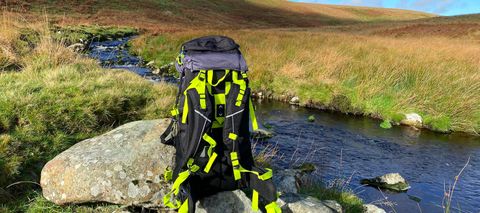
Advnture Verdict
Overall I’ve been really impressed with the Carrion 65L Rucksack from Mountain Warehouse, which offers an awful lot of functionality, carry capacity and comfort for a backpack that is considerably cheaper than most similar-sized and specced packs on the market. Brilliant for backpacking adventures of two or more days, where you need to carry a tent, sleeping bag, camping mat, stove and various other essentials, the Carrion 65L can accommodate an astonishing amount of kit, with multiple pockets to help you keep things organized, and a comfortable, ventilated harness to haul it all around.
Large, extendable main storage area
Top and side access to main compartment
Loads of pockets inside and out
External carry hoops for trekking poles, etc
Rain cover included
Slightly busy feel, with one too many pockets on the front
No recycled content
No hook for hydration bladder
You can trust Advnture Our expert reviewers spend days testing and comparing gear so you know how it will perform out in the real world. Find out more about how we test and compare products.
Mountain Warehouse Carrion 65L Rucksack: first impressions
My initial thoughts upon inspecting the Mountain Warehouse Carrion 65L Rucksack was that the designers had gone a bit overboard with the inclusions, trying to please everyone by chucking the kitchen sink at this hiking backpack.
• List price: $99.99 (US) / £119.99 (UK) • Volume: 65L / 2.3cu • Weight: 2kg / 4lb 6.5oz • Dimensions (HxWxD): 68m x 41cm x 38cm / 27in x 16in x 15in • Sizes: One, with an adjustable harness • Colors: Charcoal / Pale Green
Covered in a myriad of pockets, pouches, hooks, hoops and straps, it’s certainly a busy-looking bag, and hikers and travellers who prefer a clean, straightforward design will probably find it fiddly and fussy.
Having now used the Carrion 65L on some overnight hiking adventures, however, I have changed my mind on this somewhat, and learned to love the many features and facilities of this very capable pack.
In terms of functionality and build quality, it feels almost on par with some of the best hiking backpacks on the market, but it has a considerably lower price tag than large packs from brands such as Osprey and Deuter, and it can often be found heavily discounted, making it a really attractive and practical option for people new to multi-day hiking and those on a budget.
Mountain Warehouse Carrion 65L Rucksack: on the trails
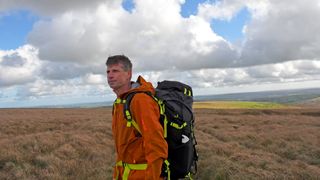
I’ve taken the Mountain Warehouse Carrion 65L Rucksack on various multi-day hiking escapades, including an excellent wild camping trip on Dartmoor. On test, I found this reasonably priced hiking backpack to be more than capable of hauling all the gear I required for overnight adventures and backpacking expeditions.
The large main compartment has a double toggle closure system on the top, which means you can extend the carry capacity if you really need to (I’d advise against this if at all possible when hiking, as it can really affect your balance – or at least make sure you pack the rucksack properly , with heavier items stowed lower down – but it can be useful when you’re travelling).
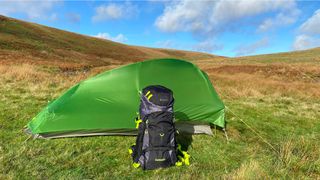
The massive main compartment can be accessed from the top, or via a zipped side pocket, which is really useful for finding inadvertently buried items when you suddenly realize that you need them while out in the wilds – it means you can locate whatever it is you’re rummaging for without emptying the contents of the pack onto the trailside.
There is a multitude of pockets on the Carrion, which makes organizing your kit easier when you’re backpacking – allowing you to keep items such as head torches , rain jackets and waterproof trousers somewhere easily accessible. These include two pockets in the hood (one on the inside and one on the outside), a large pouch on the front (with an extra tiny pocket on top of it) and a pair of good-sized pockets on the hip wings (ideal for carrying trail snacks, a compass and a phone) – all of which zip shut. I still think the smallest pocket on the front of the pack is a bit superfluous, but it doesn’t do any harm.

All the zips on this pack feature large pull tabs, which can be easily operated with gloved hands. In addition to the closed pockets there are bottle-carrying pouches on either side of the pack, plus an inner pouch for carrying a hydration bladder (although, annoyingly, there’s no hook to hang the reservoir from), and a portal for the hose on the right shoulder.
On the outside of the pack you’ll find straps for carrying trail tools such trekking poles and ice axes , and various hoops and loops that can be used to hook flashlights and other items on to. There are compression straps on the side, too, that not only help you keep the contents of the pack well contained, but can also be called into action to help hold items such as closed-cell camping mats in place.
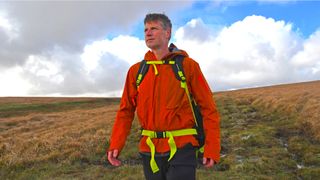
The Carrion comes in one size only, but the harness can be raised or lowered quickly and easily. The waist belt is wide and comfortable, incorporating two wings that help seat the backpack properly on your hips, and the sternum strap is very easy to adjust. Two shoulder wings keep the pack proud of your back (slightly), to allow some airflow and cut down on sweating.
The main straps are made with a mesh outer fabric to facilitate some ventilation as well, and they’re well padded for greater comfort. The whole harness and backrest system might not be quite as sophisticated and well ventilated as the ones you’ll find on premium packs from Osprey and Deuter, but it’s still comfortable to wear, even on long days on the trail.
Something the Carrion 65L does have that many more expensive backpack brands skimp on (and, annoyingly, try and sell you separately) is a rain cover, which is found in a zipped pocket on the very bottom of the pack.
- How Advnture tests products
Author of Caving, Canyoning, Coasteering… , a recently released book about all kinds of outdoor adventures around Britain, Pat has spent 20 years pursuing stories involving boots, bikes, boats, beers and bruises. En route he’s canoed Canada’s Yukon River, climbed Mont Blanc and Kilimanjaro, skied and mountain biked through the Norwegian Alps, run an ultra across the roof of Mauritius, and set short-lived records for trail-running Australia’s highest peaks and New Zealand’s Great Walks. He’s authored walking guides to Devon and Dorset , and once wrote a whole book about Toilets for Lonely Planet. Follow Pat’s escapades on Strava here and Instagram here .
First look: Keen’s WK450 Dirt trail shoe is designed to help you pick up the pace on your hike
"The post-100 burps are real" – 3 gels an hour and pushing Zone 3 all the way, David Roche explains how he broke the Leadville 100 record
Want a hands-on job at Yosemite? Under-30s are wanted for conservation internships
Most Popular
- 2 First look: Keen’s WK450 Dirt trail shoe is designed to help you pick up the pace on your hike
- 3 "The post-100 burps are real" – 3 gels an hour and pushing Zone 3 all the way, David Roche explains how he broke the Leadville 100 record
- 4 Hikers love this ankle-height version of Hoka’s famous trail-running shoe – and they're $35 off right now
- 5 Elite ultra runner reveals how on-trail mugging left him in pieces, but now he's back and determined to win the UTMB
- Magazine Subscription Offer
- Newsletters
- Competitions
- Holiday ideas
- Wildlife stories
- Marine life
- Insects and invertebrates
- Trees and plants
- Farm animals
- Experiences
- Historical figures
- Green living
- Food & recipes
- Foraging guides
- Outdoor skills
- Craft ideas
- Photography
- Latest issue
- Meet the team
- Countryfile TV guide
- Countryfile presenters
- Countryfile calendar
Mountain Warehouse Pace 30L review
Looking for a affordable backpack with a range of features for country walks? The Mountain Warehouse Pace 30L might be for you
Long feature list Good value
Finishing Basic hip and shoulder straps

RRP: £69.99 – or use our deal-finder for a good price:
Mountain Warehouse has forged a name for itself based on its good value outdoor kit, with much of it rarely on sale at full price for long.
So although the Pace 30L has an RRP of £69.99, it’s likely to be available for less if you’re looking to purchase (certain colourways are currently on sale as I write this for only £42.99; see the widgets above and below for the latest deals).
Despite the relatively low price, this walking backpack has a lot going for it. The 30L capacity offers adequate space for most one-day adventures, with plenty of room for additional layers, food and items such as a first aid kit.
Organisation is decent, with a large main compartment serviced by a zip that travels around the top of the pack and two-thirds of the way down the front.
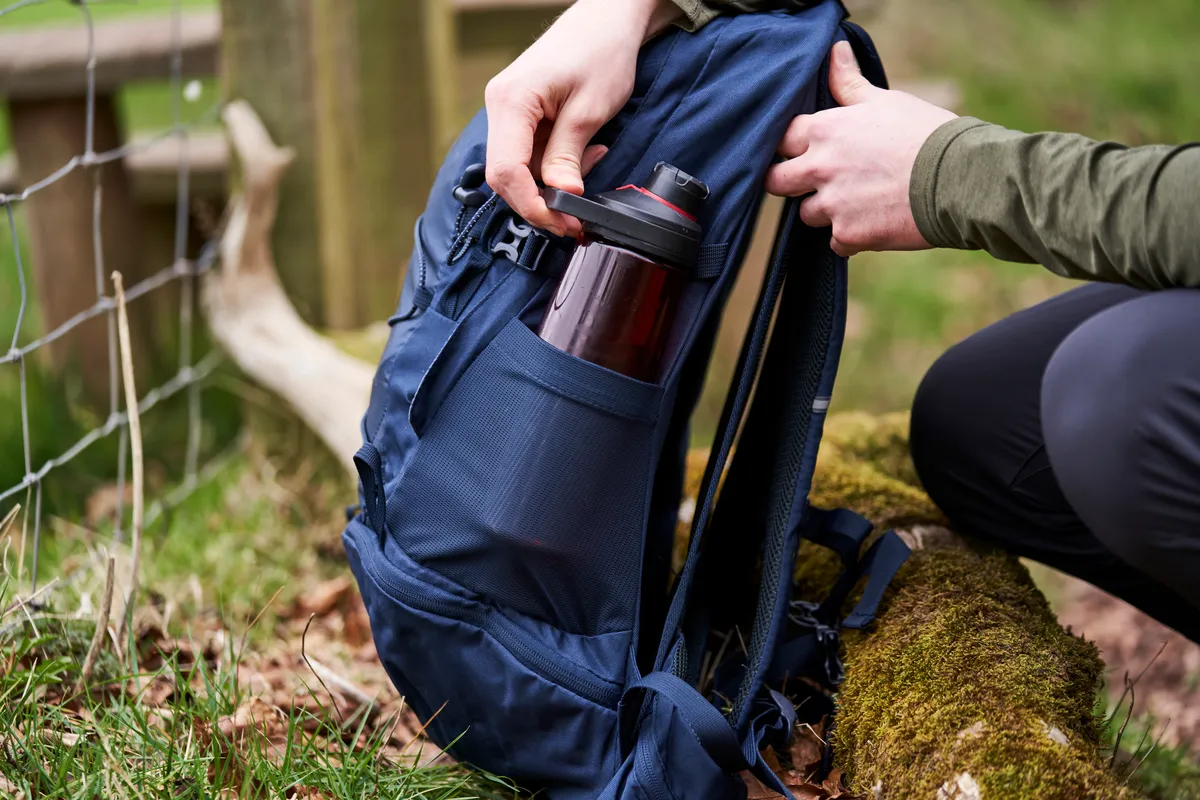
This means it’s sometimes possible to grab an item from halfway down the pack without opening up the compartment entirely.
One thing to note on that main compartment, however, is that the frame of the pack does impede access, making it a narrower area to load.
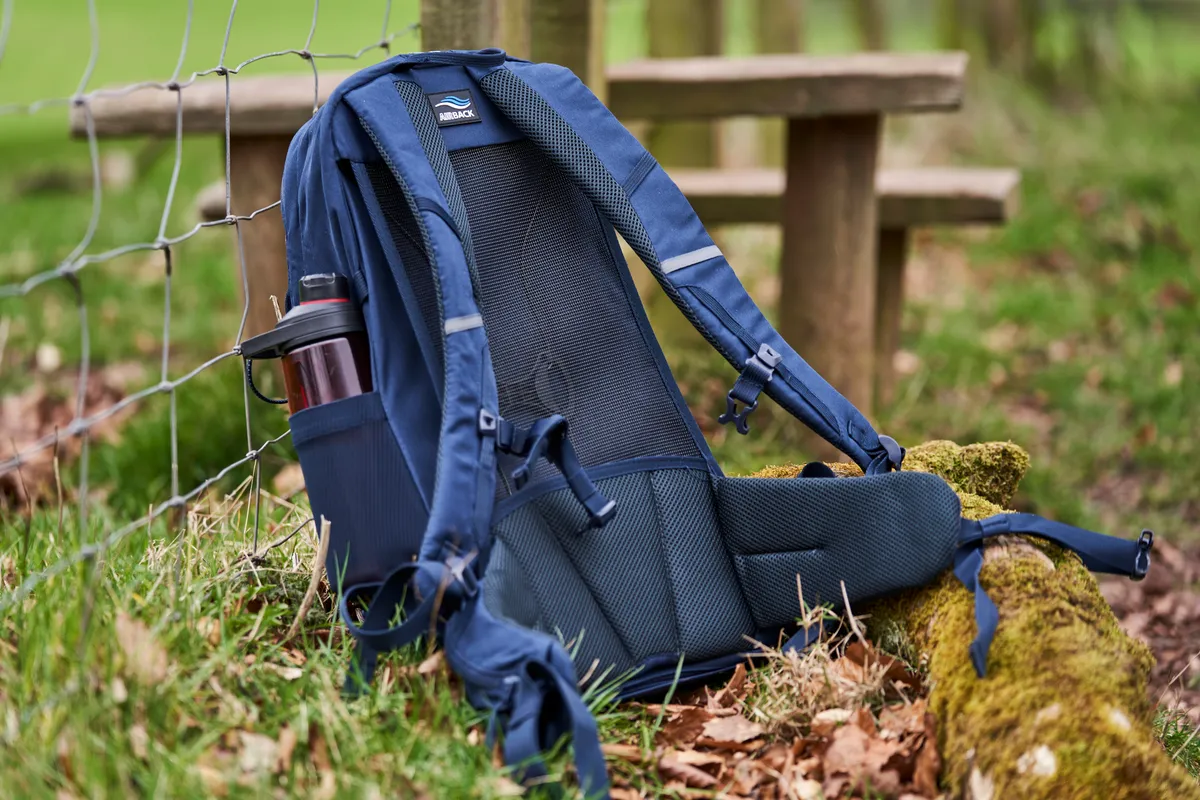
Beyond that, you also get a small zip pocket on the top that’s ideal for a head torch and neck tube, plus a separate zip pocket at the bottom that I found particularly useful for stashing waterproofs. There’s also a small zip pocket on the hip belt.
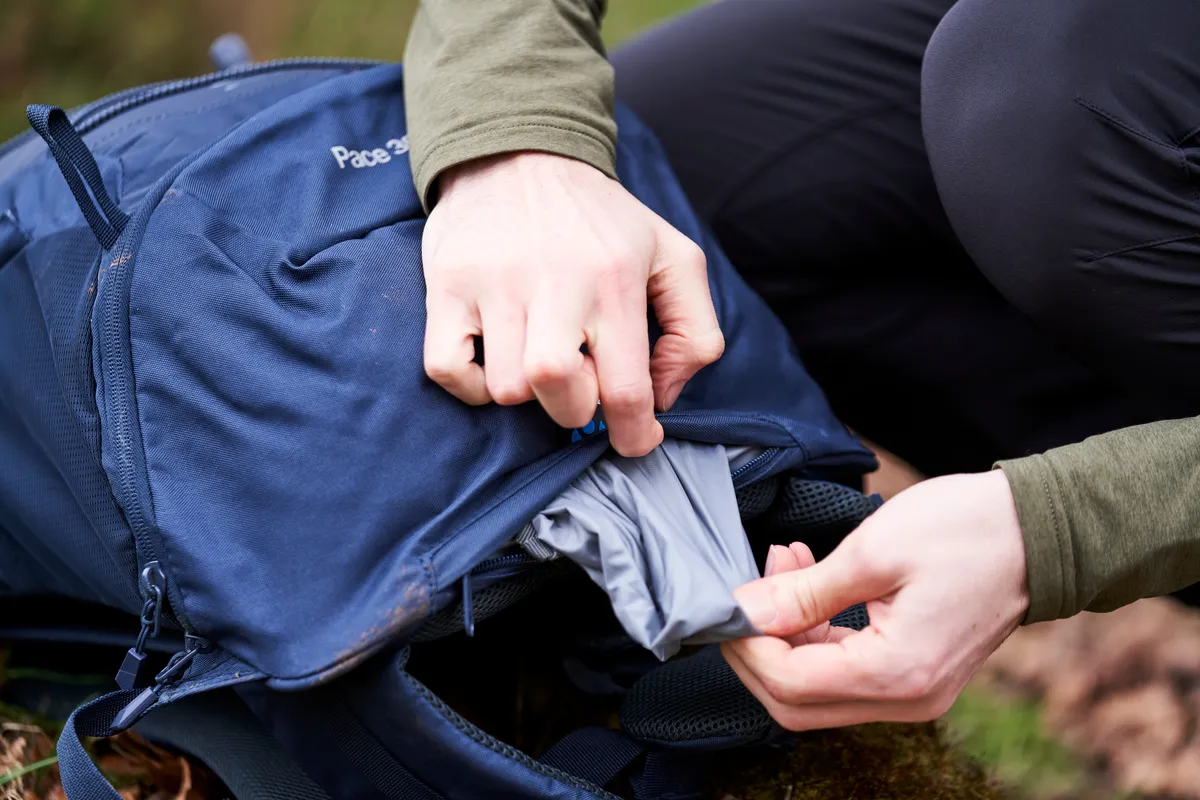
I was impressed by the strong feature list, too, with attachments for walking poles or ice axes, two elastic side pockets for water bottles (but these aren’t easy to access while walking), a rain cover, a pouch for a hydration reservoir and a bungee cord on the front for lashing extra layers to the bag.

So what’s it actually like to wear? Well, the trampoline-style back system worked well at keeping our back fresh and comfortable, but the padding on the shoulder and hip straps are quite basic.
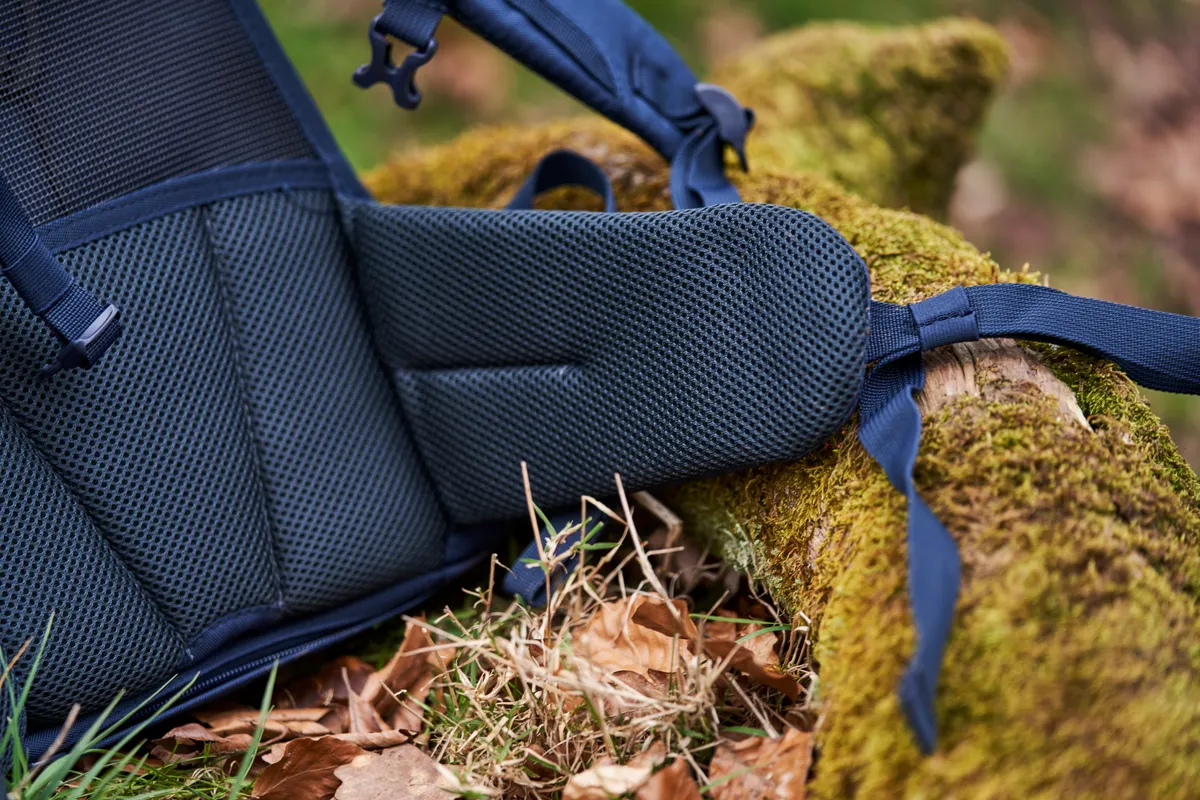
As a result, they didn’t prove as comfortable as alternative options here and lacked any moisture wicking properties.
Some of the materials also felt quite cheap, while the finishing left a little to be desired and the zip wasn’t all that smooth to operate.
Facts at a glance: Mountain Warehouse Pace 30L backpack
- Volume : 30L
- Rain cover : Yes
- Hydration bladder compatible : Yes
- Hiking pole attachments : Yes
- Whistle : No
- Ice axe compatible : Yes
- Extra features : Bungee cord
- Weight : 870g
Ready to buy? then try our deal-finder...
Also consider...
Osprey men's Manta 34L backpack
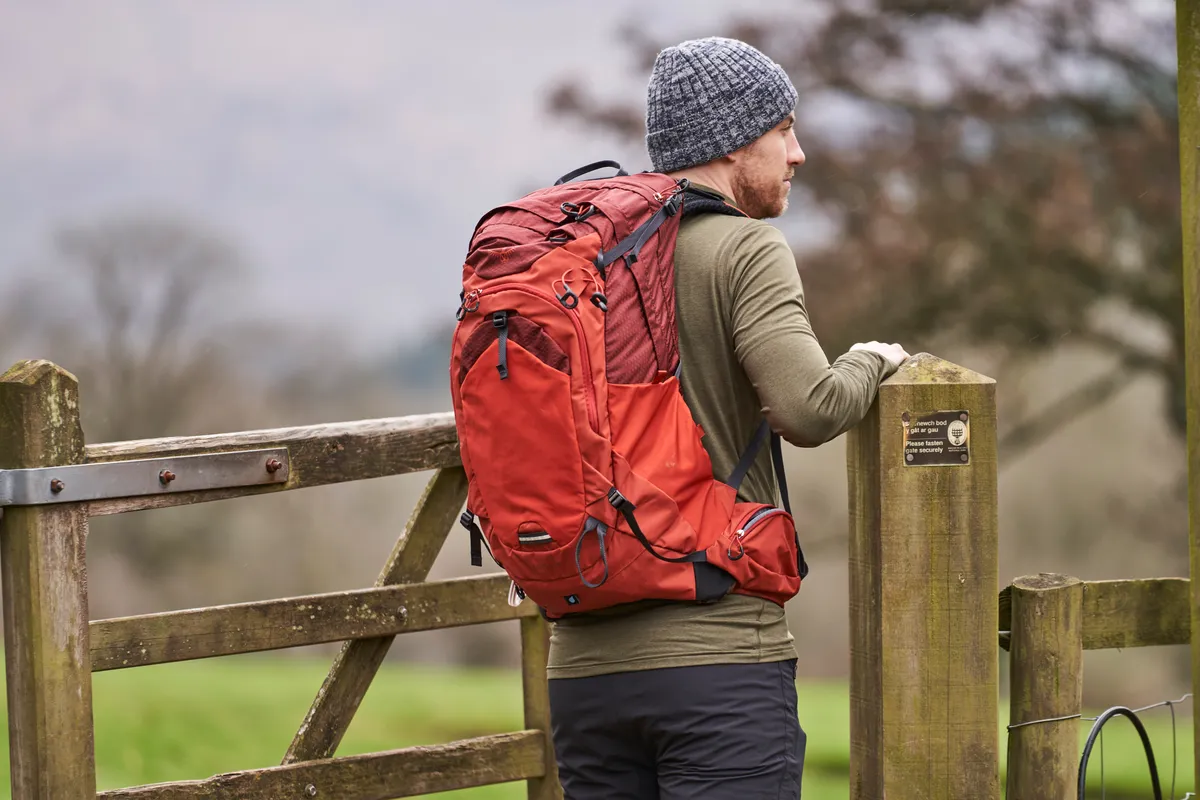
If you're a devoted hiker willing and able to invest in a high quality pack, consider the Osprey Manta 34L, or its very similar sister pack for women, the Mira 32. Similar in size to the Mountain Warehouse Pace 30L, the Manta 34L stands apart by offering next-level comfort and impressive materials and finish. The 'body-specific fit' feels like it's moulded to your back, and there's a top-notch feature-set, including a rain cover. Impeccably suited to long hikes in changeable conditions – including mountain breaks – it's hard to find any faults with this high-quality pack. Interested? Then read our full review of the Osprey Manta 34L.
Looking for more options? Check out our roundup of the best hiking backpacks to buy in 2023.
Share this article

Outdoor gear reviewer and content editor

- Terms & Conditions
- Privacy Policy
- Cookies Policy
- Code of conduct
- Manage preferences

- Visit Our Blog about Russia to know more about Russian sights, history
- Check out our Russian cities and regions guides
- Follow us on Twitter and Facebook to better understand Russia
- Info about getting Russian visa , the main airports , how to rent an apartment
- Our Expert answers your questions about Russia, some tips about sending flowers

Russian regions
- Bashkortostan republic
- Chuvashia republic
- Kirov oblast
- Mari El republic
- Mordovia republic
- Nizhegorodskaya oblast
- Orenburg oblast
- Penza oblast
- Samara oblast
- Saratov oblast
- Tatarstan republic
- Udmurt republic
- Ulyanovsk oblast
- Map of Russia
- All cities and regions
- Blog about Russia
- News from Russia
- How to get a visa
- Flights to Russia
- Russian hotels
- Renting apartments
- Russian currency
- FIFA World Cup 2018
- Submit an article
- Flowers to Russia
- Ask our Expert
Perm city, Russia
The capital city of Perm krai .

Perm - Overview
Perm is a city located on the territory adjacent to the western slope of the Urals in the east of the European part of Russia, the administrative center of Perm Krai, a transport hub on the Trans-Siberian Railway. It is a large diversified industrial, scientific, cultural, and logistics center of the Urals.
The population of Perm is about 1,043,000 (2022), the area - 800 sq. km.
The phone code - +7 342, the postal codes - 614000-614575.
Perm city flag
Perm city coat of arms.
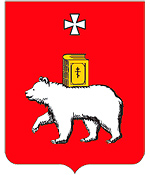
Perm city map, Russia
Perm city latest news and posts from our blog:.
1 August, 2018 / Berezniki - the City of Sinkholes .
12 October, 2017 / Northern Urals: Manpupuner Plateau and Dyatlov Pass .
3 March, 2016 / Winter in Perm city - the view from above .
18 January, 2016 / Holy Cross Cathedral on the White Mountain in the Perm region .
3 September, 2015 / The giant sinkhole near Solikamsk tripled .
More posts..
History of Perm
Foundation of perm.
The territory of Perm has been inhabited by people since ancient times. More than 130 archaeological sites, from the Stone Age to the late Middle Ages, have been studied here. About 17 thousand years ago, there was a Paleolithic site in the center of today’s Perm. During the excavations, several thousand different stone tools were found. The inhabitants of the site were hunting reindeer and horses.
In the 17th century, these lands belonged to the Stroganovs family, famous Russian merchants. The first written mentions of a settlement on the territory of the historical center of Perm (the village of Yegoshikha) date back to 1647.
In 1720, by order of Emperor Peter I, Vasily Tatishchev, the managing director of the Ural state-owned factories, a famous Russian historian and geographer, went to Siberia Governorate to build factories for smelting copper and silver. He chose a place near the village of Yegoshikha for the construction of a copper smelter because of the presence of copper ore and a river for the transportation of goods.
In 1723, the construction of the Yegoshikhinsky copper-smelting plant began, which became the moment when Perm was founded. In 1736, the Motovilikhinsky copper-smelting plant was founded about 4 km from the Yegoshikhinsky plant upstream of the Kama River.
More Historical Facts…
In 1759, the village near the Yegoshikhinsky plant was destroyed by fire, only the church and several houses around it survived. In 1764, instead of the wooden church, a stone one was built - the Peter and Paul Cathedral - the first stone (brick) building in Perm. This building has survived to this day.
In 1780, Empress Catherine II signed a decree on the creation of a town named Perm on the basis of the Yegoshikhinsky plant, which became the center of Perm Governorate. In 1783, the coat of arms of Perm was approved with the following description: “In a red field there is a silver bear, on which the Gospel is placed in a gold frame, above it there is a silver cross, meaning the savagery of the indigenous people and enlightenment through the adoption of the Christian law”. Today’s coat of arms of Perm is the same.
In 1788, the Yegoshikhinsky plant was closed due to the depletion of deposits. Copper production continued at the Motovilikhinsky copper smelter. Perm began to develop as an administrative, trade, transport, and cultural center of the Urals.
Perm in the 19th - early 20th centuries
In 1840, British geologist Sir Roderick Impey Murchison, studying vast outcrops of geological strata in the vicinity of Perm, discovered the Perm geological period named after this town. In 1842, a fire broke out in Perm, in which the entire central part of the town (about 300 houses) was destroyed. In 1863, due to the depletion of copper ore, the Motovilikhinsky plant was also closed. In the same year, the Perm cannon plants were laid downstream of the Kama.
In 1868, a population census was carried out in Perm and its environs. The residents turned out to be: 11,381 men and 8,175 women in Perm, a total of 19,556 people; in the Motovilikhinsky plant there were 4,399 men and 4,321 women, a total of 8,720 people. In Perm, there were 14 churches, up to 40 stone and 2,900 wooden houses, 353 shops.
The end of the 19th century became a period of active railway construction in Perm. In 1878, the Perm - Yekaterinburg line was commissioned. In 1897-1898, the Ural railway was connected to the railway network of European Russia. Institutions of art and culture were actively developing in Perm too. In 1874, the construction of the opera and ballet theater began. In 1896, the first movie theater was opened (the electro-theater “Illusion”).
At the beginning of the 20th century, the population of Perm, together with Motovilikha, was about 100 thousand people. In 1902, the first city power plant was opened.
In 1909, Perm was visited by Sergei Prokudin-Gorsky, a pioneer of Russian color photography. In 1909-1916, with the support of Emperor Nicholas II, he traveled to capture in color contemporary Russia, its culture, history, and modernization. In the collection of his photographs published on the website of the US Library of Congress, you can find 12 photographs taken in Perm.
Perm during Soviet times
In March 1918, a railway carriage under escort arrived in Perm with the Grand Duke Mikhail Alexandrovich (the successor to the Russian throne after the abdication of Emperor Nicholas II and, according to some opinions, the last emperor of the Russian Empire), his personal secretary, and other exiles. The Grand Duke and his secretary were allowed to stay at the hotel. On the night of June 12-13, 1918, Mikhail Alexandrovich and his secretary were abducted from the hotel, taken to the forest and killed by a group of local security officers and militiamen. Their bodies have not yet been found.
During the Russian Civil War, clashes took place in the Perm region. The Bolsheviks called the capture of Perm by the Whites and their advance to the west “the Permian catastrophe”. In the summer of 1919, the Reds began to recapture these territories. Before the retreat, the Whites burned almost all water transport on the Kama, and also blew up the railway bridge across the river.
In 1923, Perm lost its status as a regional center, since, according to the new administrative-territorial division, the Ural region was formed with the center in Sverdlovsk (Yekaterinburg).
According to the 1926 population census, the population of Perm was 84,804 people (39,968 men and 44,836 women). On November 3, 1927, Perm and the village of Motovilikha were united into one city. In 1931, Motovilikha received the status of an independent town called Molotovo. In 1938, it was re-incorporated into Perm under the name of the Molotov district (Motovilikhinsky district today).
By 1939, due to industrialization, the city’s population had more than tripled and amounted to 306 thousand people. On March 8, 1940, the city was renamed Molotov in honor of V.M. Molotov, a politician and chairman of the USSR government in 1930-1941.
During World War II, the city’s industry was reoriented towards military needs. Molotov Oblast became one of the main regions that received the evacuated population and enterprises. A total of 124 industrial enterprises were transferred to this region, of which 64 resumed production in Perm.
In 1955, the construction of the Kama hydroelectric power station was completed. On October 2, 1957, the name Perm was returned to the city in connection with the condemnation of the so-called “personality cult” that began in the USSR after Stalin’s death (Stalingrad was renamed Volgograd in 1961). In 1958, the first stage of the Perm Oil Refinery was put into operation. In 1967, the construction of the Communal Bridge was completed - an automobile-pedestrian bridge across the Kama connecting the city center with the right-bank part.
On March 18, 1965, on the spacecraft Voskhod-2, cosmonaut A.A. Leonov made the first spacewalk in the history of mankind. Before landing on Earth, the ship’s automatic attitude control system failed. P.I. Belyaev manually oriented the ship and turned on the braking engine. As a result, Voskhod-2 landed about 180 km north of Perm. After two nights in the open air, the cosmonauts were taken by helicopter to the Perm airport. The road in Perm (part of the Kazan tract), along which they were transported, was later named Cosmonauts Highway.
By 1979, the population of Perm was about 1 million people. Population growth in some years was 15% and was the largest among all cities in the Urals.
Perm in the 1990s-2000s
After 1991, the population began to decline continuously. In 2004, it fell below one million residents. Perm was able to regain the status of a city with a population of more than one million people only in 2011.
In the 1990s, the football club “Amkar” and the basketball club “Ural Great” were founded in Perm. In the 2000s, they achieved success in Russian football and basketball (Amkar played in the Premier League, was a finalist of the National Cup and a participant in the UEFA Cup, Ural Great became a two-time champion of Russia).
In 2005, Perm became the administrative center (capital) of Perm Krai, formed as a result of unification of Perm Oblast and the Komi-Permyak Autonomous Okrug.
The end of the 2000s was overshadowed by several tragic incidents related to Perm: a passenger plane crash on September 14, 2008 (88 dead) and a fire in the nightclub “Lame Horse” on December 5, 2009 (156 dead and 78 injured).
Pictures of Perm
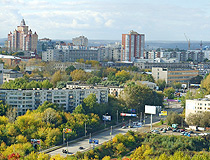
Perm cityscape
Author: Valery Bukirev
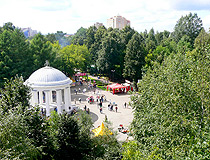
Rotunda in Gorky Park in Perm
Author: Prokhor Shuchalov
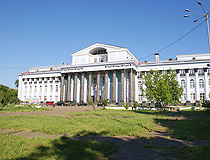
The Palace of Culture named after Lenin in Perm
Author: Yury Baranov
Perm - Features
The districts of Perm are located relatively far from each other and are often separated by forests, because the city was formed as a conglomeration of settlements scattered along the banks of the Kama River. Therefore, Perm is the third largest city in Russia by area after Moscow and St. Petersburg. It stretches along the Kama for 70 km and ranks third in length after St. Petersburg and Sochi.
Another characteristic feature of this city is a number of small rivers flowing mainly along the numerous city ravines. Forests occupy almost half of the territory of Perm (about 400 sq. km.). The City Day of Perm is celebrated on June 12, simultaneously with the Day of Russia.
The word “perm” appeared in Russian language a long time ago. It was first recorded in the chronicle “The Tale of Bygone Years” dating from the early 12th century, which listed the names of various tribes. Today, most researchers of Permian toponymy think that “pera maa” (“remote, distant land”) was the territory in which the ancestors of the present Komi-Zyryans lived. In accordance with the peculiarities of the Old Russian language, the word “pera maa” was transformed into “perm”.
Thus, first the land in the basin of the Vychegda River and the tribes living on it began to be called Perm. And then this word began to be used to call the land and tribes in the basin of the Kama River - that is, the place of residence of the Permian Komi (Great Perm). Later this name spread to the entire territory of today’s Perm Krai. At the end of the 18th century, it gave the name to Perm Governorate and its capital - Perm.
The climate of Perm is moderately continental with high humidity due to the location on the river and the proximity of the Kama reservoir. Winters are snowy and long; summers are moderately warm. The average temperature in January is minus 12.8 degrees Celsius, in July - plus 18.6 degrees Celsius.
Perm plays an important role in the economy of Russia. The city’s economy is characterized, first of all, by a developed heavy industry. The leading industries are electric power generation, oil and natural gas processing, mechanical engineering, chemistry and petrochemistry, woodworking, printing, and food processing. In mechanical engineering, a significant share is made by enterprises of the military-industrial complex. One of the largest Russian bicycle manufacturing enterprises, “Forward”, is located in Perm.
This city is one of the largest transport hubs in the country. Perm occupies a particularly advantageous geographical position, as it is located in the center Russia at the intersection of the railway from Europe to Asia (the Trans-Siberian Railway) with a sub-meridional waterway to the five seas. Perm is home to the two easternmost river ports in Europe. From here it is possible to transport goods to the ports of the Baltic, White, Black, Azov, and Caspian seas.
Perm International Airport (Bolshoye Savino) offers regular flights to Moscow, St. Petersburg, Sochi, Krasnodar, Nizhny Novgorod, Novosibirsk, Rostov-on-Don, Surgut, Ufa.
All major sights, theaters and museums are concentrated in the city center, on the left bank of the Kama. It is difficult to get lost in the historic part of Perm. The city was built quite logically - wide streets were constructed parallel to the Kama River. Less significant streets and lanes connect them to each other. Perm managed to preserve a lot of architectural monuments of the 19th and 20th centuries.
Main Attractions of Perm
The Kama River Embankment - one of the main recreation places for residents and visitors of Perm attracted here by picturesque landscapes and a rich cultural life (exhibitions, festivals, art projects, installations, concerts, sports competitions, etc.). The length of the embankment is about 4 km.
One of the attractions of the embankment is the picturesque building of the Perm River Station (Monastyrskaya Street, 2) built in the Stalinist Empire style, in which an interactive exposition “Russia - my history” is open.
Opposite the river station you can see the art object “Happiness is not far off” - one of the most recognizable sights of Perm. The two-meter red letters that make up the inscription are one of the main symbols of the city. This art object became famous in Russia when after water discharge at the Kamskaya hydroelectric power station this part of the embankment was flooded. The “floating” inscription about happiness got a lot of attention on Russian social networks.
Perm State Art Gallery . This museum has one of the oldest and most valuable collections of art objects in Russia, more than 50 thousand works of art created in the period from ancient to modern times. There are collections of Perm wooden sculpture, icons, engravings, antique ceramics, medieval painting, etc. The exposition is located in a building that is an architectural monument - the Transfiguration Cathedral (1793-1832). Komsomolskiy Prospekt, 4.
Sculpture “Permyak Salty Ears” - an urban sculpture made in the form of a circle-frame with ears, where you can place your face and take a picture. The composition also includes the figure of the photographer standing opposite, ready to take a picture with an old camera. The sculpture is located opposite the building of the hotel “Prikamye” at Komsomolskiy Prospekt, 27.
It is the traditional nickname of the residents of the Perm region. The origins of this expression go back to the 15th century, when salt began to be mined here. Salt workers often had to carry heavy bags of salt on their shoulders. From constant contact with a caustic substance, their ears were swollen and reddened.
Perm Regional Museum - the oldest and largest museum of the Perm region, which includes more than 50 collections of regional, Russian, and world significance. The main exhibition is called “The History of the Kama Region” and consists of exhibits (household items, jewelry, books) telling about the life of people who lived in Perm Krai, from ancient times to the 20th century. The museum occupies an old mansion, which is known as Meshkov’s House (a famous merchant and philanthropist). Monastyrskaya Street, 11.
A branch of this museum is the Museum of Permian Antiquities , the main exposition of which includes skeletons, fossils, scientific reconstructions of ancient animals, ores, and other paleontological and geological finds. Sibirskaya Street, 15.
Architecture of Perm
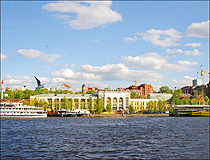
Perm River Station
Author: Dmitry A.Shchukin
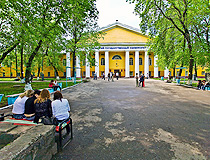
Perm State University
Author: Yuriy Chulkov
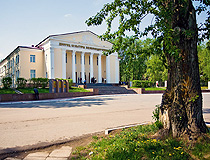
The Palace of Culture of Railwaymen in Perm
Museum “Motovilikha Factories” . The foundation and development of Perm was largely due to the construction of metallurgical factories in the 18th century. Then this area was called Motovilikha. The museum exposition is dedicated to the history and development of these enterprises. Part of the collection located in the open air and consisting of massive artillery pieces and rockets produced at different times is of particular interest. 1905 Goda Street, 20.
Perm Museum of Contemporary Art (PERMM) - the first museum of contemporary art in Russia located not in Moscow or St. Petersburg. The museum has exhibits united by such artistic phenomena as “Russian Poor Art”.
This term refers to works of art created by Russian artists, who work with non-artistic, non-traditional, “poor” materials: unbaked clay, sand, packing tape, foam rubber, cardboard, etc. “Russian Poor Art” reflects a powerful international trend that has already become part of the world and Russian art history. Gagarina Boulevard, 24.
Perm Esplanade . The territory of the esplanade (undeveloped, open space, wide street with alleys) runs along Petropavlovskaya Street and Lenina Street. This is one of the most popular public spaces in Perm. Festivals, celebrations, and other events are held here all year round. The central point of the esplanade is the Monument to the Heroes of the Front and Rear consisting of three standing figures: a warrior, a worker, and the Motherland. The Alley of Valor and Glory is located nearby.
Perm Central Mosque (1902-1903) - the first mosque in Perm, a beautiful monument of architecture of regional significance. The main feature of this building is its eclectic style, characterized by a harmonious combination of elements of oriental architecture and features of Russian folk architecture. Osinskaya Street, 5.
Peter and Paul Cathedral (1757-1781) - one of the oldest stone buildings in Perm erected in the Russian Baroque style at the site of the city’s foundation next to the first copper smelter. Sovetskaya Street, 1.
Perm Stefanov Holy Trinity Monastery - an impressive snow-white architectural ensemble, which is one of the most memorable architectural objects in Perm. The building of the monastery combines two architectural styles at once - Old Russian and Byzantine. It is completely different from other Perm churches and rather resembles old Moscow churches. Visimskaya Street, 4?.
Monument to the Letter P (Perm Gate) - an unusual art object installed in the park of the 250th anniversary of Perm near the central railway station on Lenina Street. The height, width, and depth of the object, consisting of 5,200 randomly fastened spruce logs, is 12 meters. The shape of the facades is made in the form of the letter “P”. Here you can also see a garden of rocks and another unusual art object - a scarab beetle rolling a large ball in front of it.
Gribushin’s House - a picturesque Baroque mansion with Art Nouveau elements, one of the most beautiful buildings in Perm. It was built for the family of one of the city officials at the end of the 19th century. In 1905, the merchant S.M. Gribushin bought the house and rebuilt it according to his taste. In 1919, the merchant’s family left Russia and the building was nationalized. Today, the Perm Scientific Center of the Ural Branch of the Russian Academy of Sciences is located here. Lenina Street, 13?.
Architectural and Ethnographic Museum “Khokhlovka” . It is located on the picturesque bank of the Kama River, about 40 km from Perm. Founded in 1969, it became the first museum of wooden architecture in the Urals. The exposition is a group of buildings dating back to the 17th - first half of the 20th centuries. Some houses have recreated historical interiors and ethnographic collections.
Belogorsky St. Nicholas Missionary Monastery . Belaya (White) Mountain (715 m) is located about 70 km from Perm. From here you can admire the views of the surroundings and the Ural Mountains, as well as a picturesque monastery with a huge Holy Cross Cathedral that can accommodate up to 5 thousand parishioners.
Kungurskaya Cave - a large karst cave with a length of 5.7 km with numerous lakes and grottoes located 90 km southeast of Perm, one of the most popular attractions of the Urals. It was discovered during the time of Peter the Great, at the beginning of the 18th century. The first accurate description and map of the cave was made by the famous historian Vasily Tatishchev. For tourists, only 1.7 km of underground passages are open.
Perm city of Russia photos
Monuments in perm.
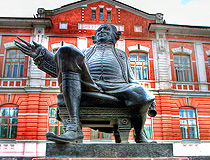
Monument to the People's Doctor F.H. Gral - the founder of the Perm provincial medicine
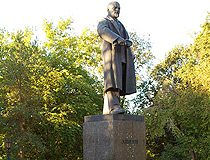
Lenin Monument in Perm
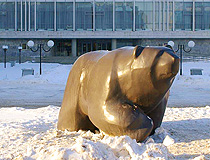
Bear sculpture in front of the Organ Concert Hall in Perm
Churches in Perm
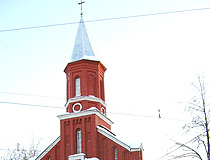
Evangelical Lutheran Church of St. Mary in Perm
Author: Anatole Woskresenski
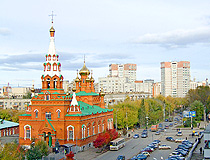
Church of the Ascension in Perm
The questions of our visitors
The comments of our visitors.
- Currently 2.96/5
Rating: 3.0 /5 (494 votes cast)

Share ×

Scan the QR code and open PeakVisor on your phone
❤ Wishlist ×
See all region register, peakvisor app.
The Perm Territory lies in the north-eastern part of the East-European Plain and on the western slopes of the Middle and North Urals in Russia . It is situated at the junction of Europe and Asia with 98% of the territory being in Europe and only 2% belonging to Asia.
Flora and Fauna
Water resources, landmarks and tourism, the basegi ridge, kolpaki mountain, mount oslyanka, ski and sports facilities, the divya cave, the kungur cave, the orda (ordinskaya) cave, the miracle cave, protected sites (reserves, national and natural parks), water resources, the vizhay river, the vilva river, the koiva river, the usva river, alexandrovsk blue lakes, the white sea in berezniki, zoo nurseries, major cities.
In the distant past, this territory was called Perm the Great. The name came from the word ‘Permaa’, which meant ‘a distant land’. The capital of Perm the Great was Cherdyn which was considered the oldest city of the Kama Region. The first province was formed in 1792 and in 2005, two big regions merged to form a huge federal land called the Perm Territory. In spite of the fact that it is geographically closely connected with the Urals when the Russian federal districts were created in the 2000s, the Perm Territory was administratively assigned to the Volga Region thus becoming a part of the Volga Federal District. Its administrative centre is the city of Perm.
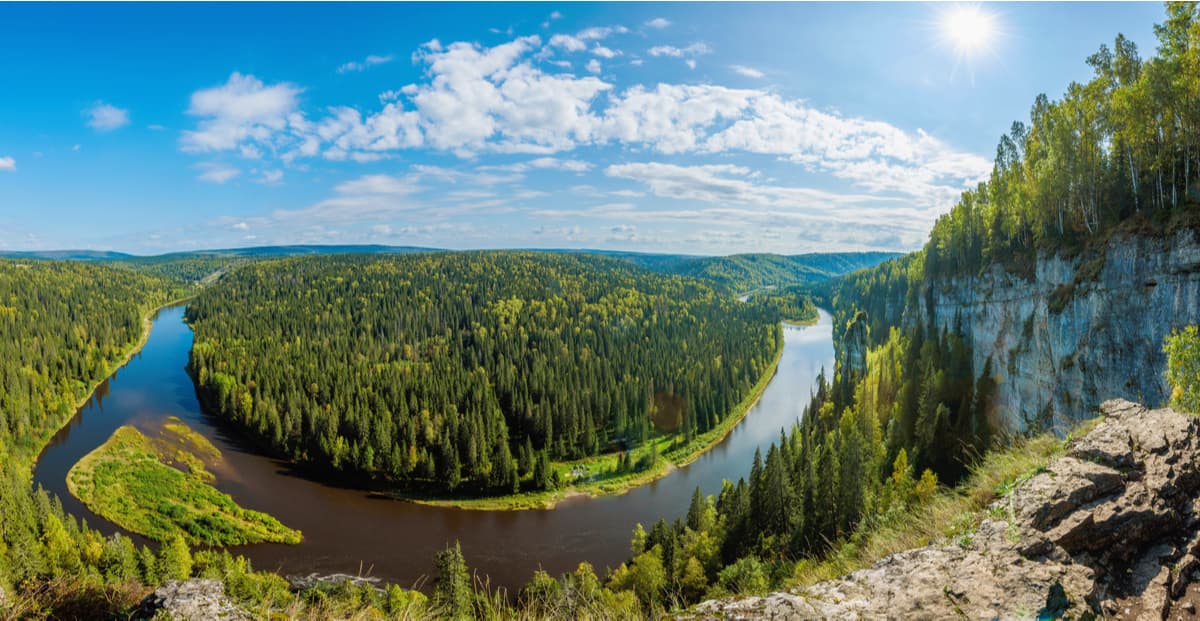
The borders of the region follow the natural terrain and are very erratic. The Perm Territory borders the Komi Republic in the north, the Sverdlovsk Region in the east, Bashkiria in the south, the Kirov Region and Udmurtia in the west.
Its territory is 160,237 sq.km., from north to south the region stretches for 645 km, from west to east – 420 km, the population is 2 599 301 people (as of 2020), most of them live in the 22 cities.
The main feature is the Ural Mountains . The western and central parts of the Territory are dominated by low and flat terrain, while in the east start large hills and lowland mountainous terrain. In the west of the plain part, there is the Verkhnekamsk Upland (with heights up to 335 m) and the Okhansk Upland continuing in the centre of the region. In the north-west, there are loosely separated hills of the Northern Urals (up to 270 m high). In the south rises the Tulva Upland (up to 446 m high) and in the south-east, there is the Sylva Ridge at the edge of the Ufa Plateau (up to 403 m high).
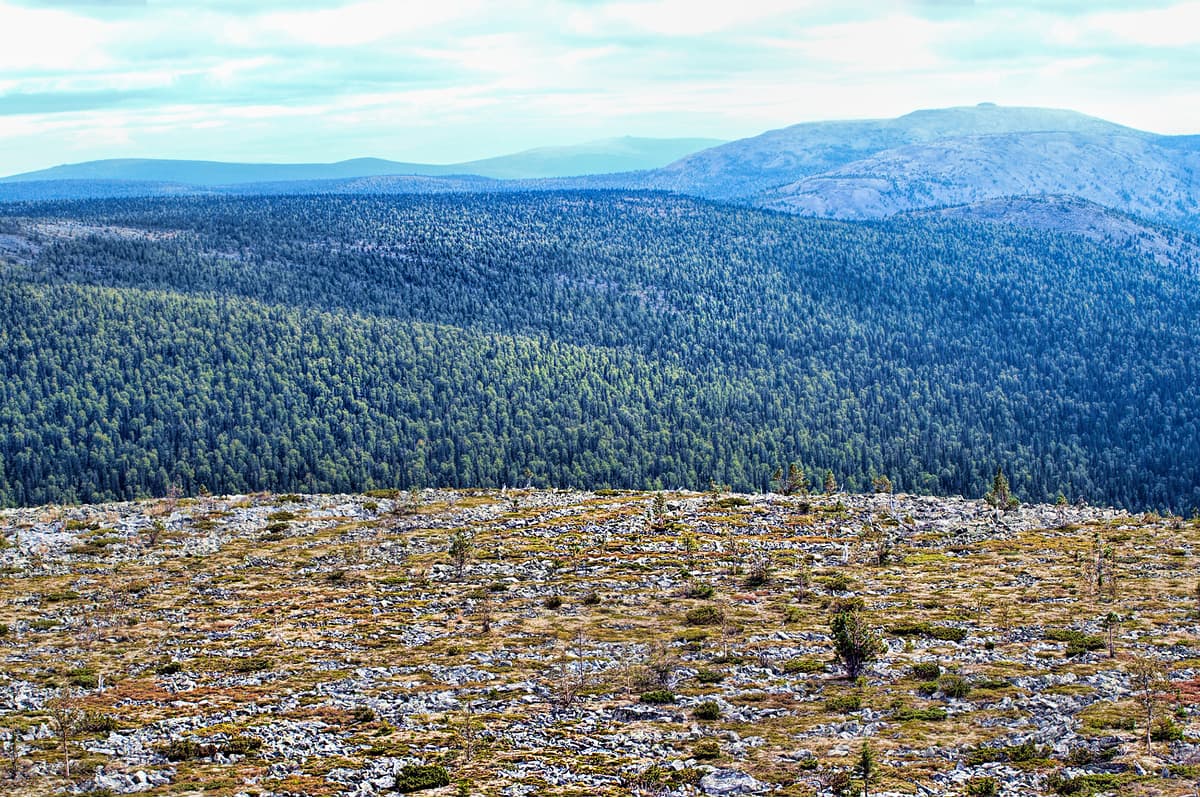
The Perm Territory is rich in karst phenomena, especially in the south-east. The highest mountains are situated in the north (the Northern Urals), there is Tulymsky Stone (1,469.8 m, the highest peak of the Perm Territory), Isherim (1,331 m), HuSoik (1,350 m), Molebny aka Prayer Stone (1,240 m), Martai (1,132 m). The usual name for mountains in the Urals is ‘stones’, they tower over the rest of the area. Among the mountains of the Middle Urals , the highest are located in the Basegi Range (993 m).
Over two-thirds of the territory is occupied by forests mainly represented by dark coniferous taiga. There are two subzones: the middle and the southern taiga. The forests in these zones differ. The middle taiga is dominated by conifers, predominantly by spruce and fir. There are two types of spruce in the territory of the region: the European and the Siberian spruce. The southern taiga features broad-leaved tree species, e.g. linden, maple, elm. Among other tree species, you can find cedar (or rather cedar pine), juniper, three species of birch (silver, downy, and drooping or nodding birch), ground cherry, bird cherry, mountain ash, and aspen. More than 60 plant species are included in the Red Book of the Perm Territory. There are a lot of endemic and relict species, most of them can be found in the many reserves located in the Perm Territory.
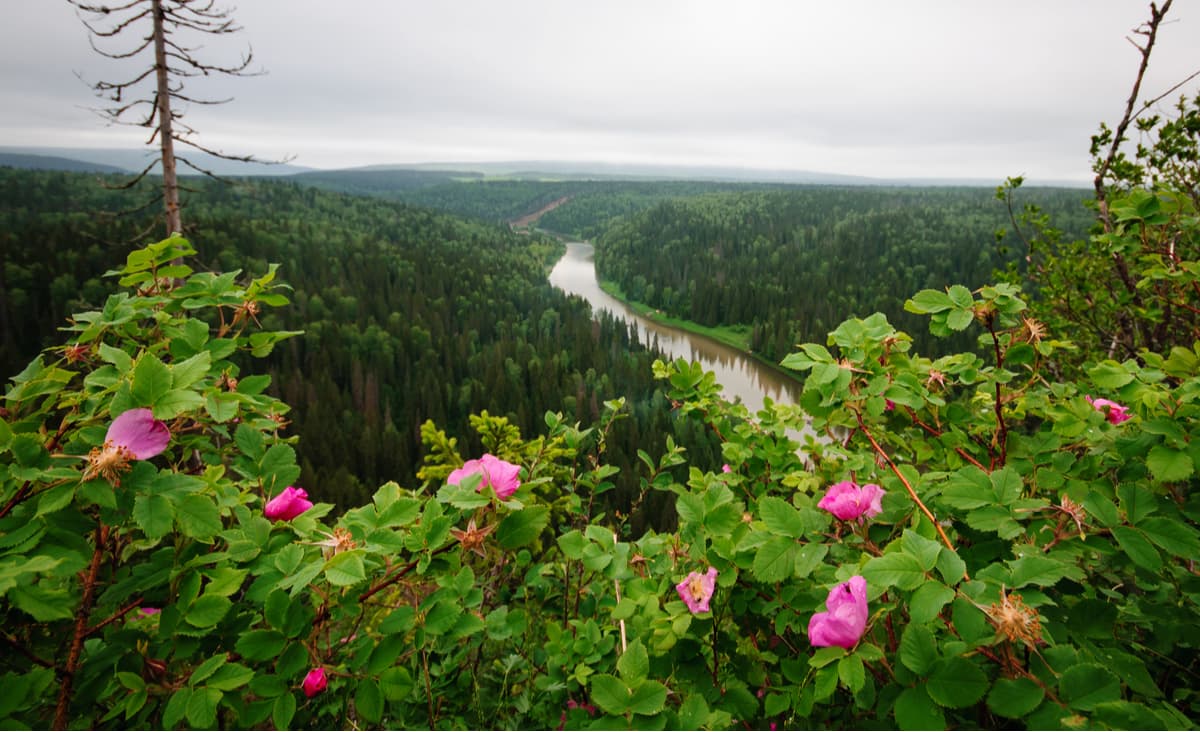
The animal world is astounding, there are 62 mammal species, 270 bird species, 42 fish species, 6 reptiles, and 9 amphibians. The most common predator is forest marten. By the number of martens, this region occupies one of the first places in Russia. There are ermine, weasel, badger, otter, wolverine living peacefully in the local forests. Bears and lynx can be found all over the territory, except the very south, but their numbers are small. Wolves and elks can also be spotted occasionally. When winters are not very snowy, roe deer can come to the eastern parts of the region from the neighbouring Sverdlovsk Region . And in the northern regions, there come deer from the Komi Republic . Hunting some animals (sable, otter, marten, moose) is possible only under special permits (licenses). Roe deer and reindeer are under protection and hunting them is prohibited.
The river network is the densest in the country, there are 29,179 named rivers. The region ranks first in Russia in terms of the rivers’ length and water capacity. The largest rivers of the region are the Kama with its tributaries of the first and second-order: the Vishera, the Chusovaya, the Kosa (Kama tributaries), the Kolva (the Vishera tributary), the Sylva (the Chusovaya tributary) and others.
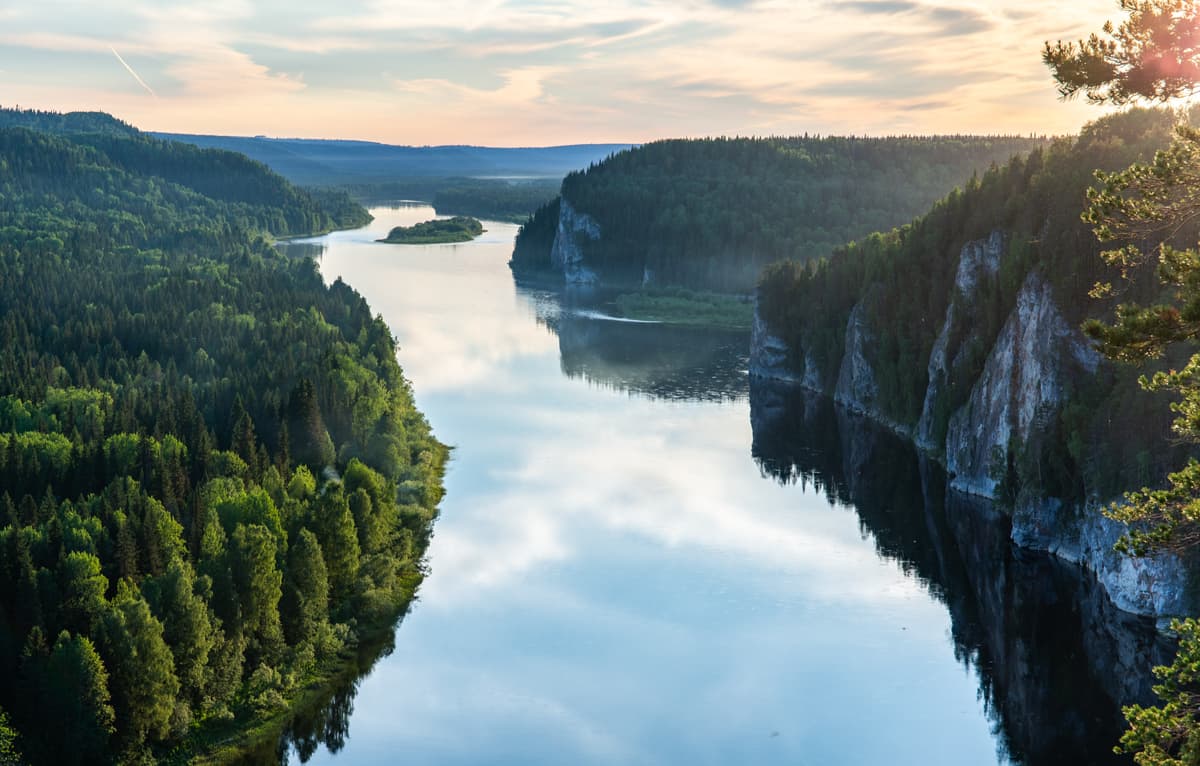
The rivers originate in the Urals. In their upper reaches, the rivers flow down the valleys between mountain ranges and have quite a measured and slow current. Yet once they approach the foothills, rivers acquire more rapid character, typical of mountain rivers, but not for long. When they reach the plains, the currents quieten down and you can enjoy a perfectly calm boat ride. The rivers are characterised by mixed feeding with a predominance of snowmelt (50-60%). Local rivers have plenty of spring floods when water levels rise dramatically and very rapidly, whereas summer and autumn seasons enjoy low water sometimes interrupted by rainfall floods. Winter is defined by low water as well. Rivers get frozen in the second half of November and open in late April – early May.
As to the lakes, the figure is mind-blowing over 5.8 thousand. Those lakes and artificial reservoirs include about 690 lakes with the area of more than 0.01 sq.km. and a huge number of smaller lakes. Most of them are located in river floodplains, mainly as meander lakes. Among the boggy massifs of the north of the Territory, there are relict lakes, and in the central areas, there are mainly karst lakes. The largest lake in the Perm Territory is Lake Chusovskoye with 18 sq.km of area. The largest reservoirs are the Kama and the Votkinskoye reservoirs on the Kama River, they were created during the construction of the hydroelectric station and the Shirokovskoye reservoir on the Kosva River.
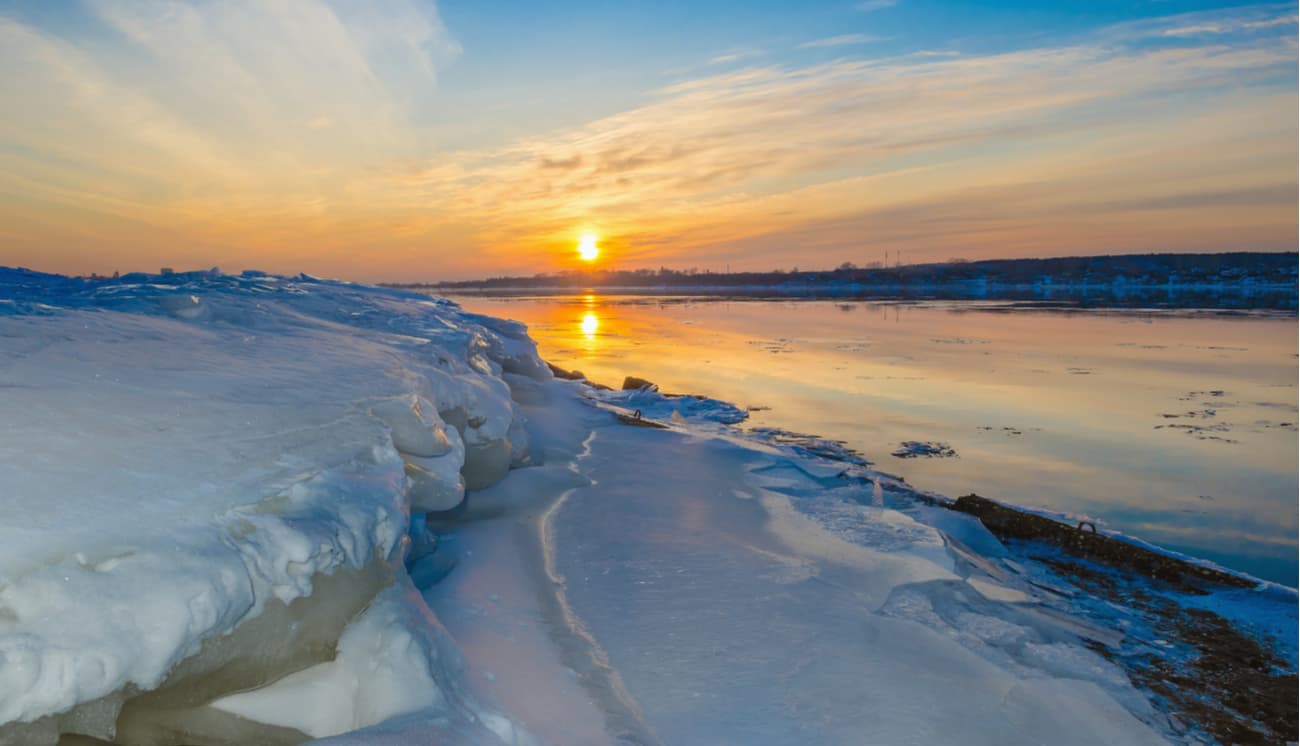
Among the federal regions of Russia, the Perm Territory is second only to Tatarstan in terms of the area of lakes and artificial reservoirs. Swamps and marshlands occupy about 2.31% of the territory which makes it number one in the country if counted by the area of marshes, marshlands and swamps of the territory as a whole. The area and the number of lakes, artificial reservoirs, swamps and marshlands are unstable and depend on natural and anthropogenic factors viz. drainage, watering of territories, etc.
The climate is moderately continental. The Basegi Ridge as well as the Urals Mountains in general are on the way to the western air mass transfer. Thus, despite the relatively low altitude, they significantly limit the spread of air blown in from the Atlantic to the east. As a result, the climate of the Perm Territory has a pronounced continental character. The seasons are distinct, you can surely tell winter from spring and summer from autumn. Winters are long, snowy, and summers are moderately warm. Winter usually starts in November, with snow cover remaining until April and in the north even until May. By March snow thickness reaches about 80-90 cm in the north and 60-70 cm in the south. In the valleys, the snow depth can reach 1.5-2 m, while at the mountain tops it does not exceed 50-70 cm.
The average temperature in January is -17 C (+1 F). There quite often occur severe cold winters with strong winds when the temperature drops to -53 C (-63 F) in the north of the region. Spring comes in early April and brings about unstable weather with extremely sharp fluctuations in temperature. In May, there is a return of cold weather with harsh frosts. The warmest summer month is July. The average temperature of July in the northeast of the region is +15 C (+59 F), and in the southwest, it is +18.5 C (+65 F). On the hottest summer days, maximum temperatures can reach +38 C (+100 F).
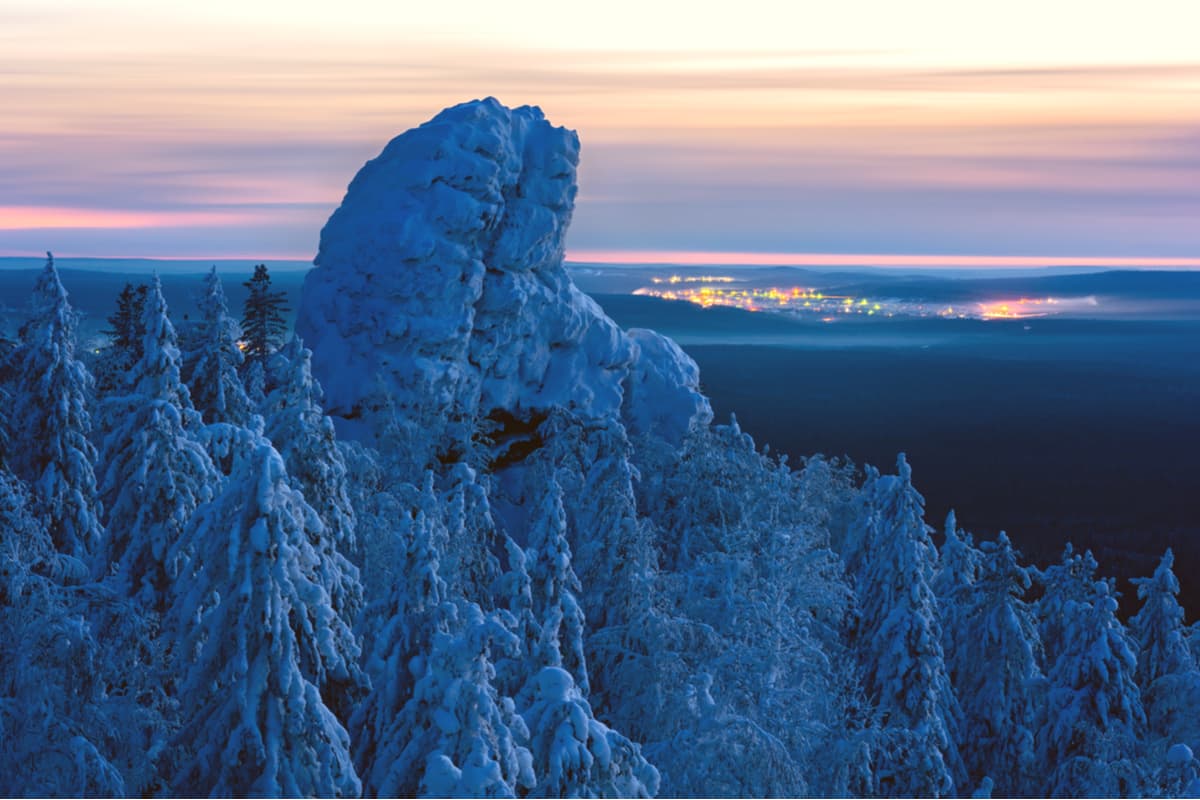
The Perm Territory is blessed with rich deposits of minerals. The world's largest reserves of potassium and magnesium salts, as well as rock salt, are concentrated here. Some time back, this region was called the Salt Capital of Russia. At the end of the 17th century, the city of Solikamsk was the centre of Russian salt production. Currently, salt making in the city has been stopped.
In earlier times, the Kama region massively mined coal. Now all coal mines are closed due to unprofitability. The first Russian diamonds were found in this region as well. The main well-developed industries of the region are oil, chemical and petrochemical, timber, ferrous and non-ferrous metallurgy, machine engineering. As to the chemical industry, mineral fertilizers are dominating the market. The main industrial centres of the Perm Territory are Perm, Berezniki, Solikamsk, Chusovoy, and Lysva. The southern parts of the Territory are agricultural.
The Perm Territory is a major cultural centre. There are many theatres, museums, numerous festivals. At the same time, natural tourism is also developed here due to great natural landmarks. These include beautiful rivers with rocky shores, mountains with wonderful panoramas, and caves with spectacular mazes and grottoes.
The most famous and popular peaks and ranges are the main Ural Mountain Range, the Tulym Range (the Tulymsky Stone), the Chuval Range (the Chuval Stone), the Kvarkush Range, the Basegi Range , the Munin-Tump Mountain, Kruglytsya Mountain, Vetlan Rock and Polyud Rock, Molebny (Prayer) Stone, Kolpaki Mountain, Oslyanka Mountain , Stone City Rocks, Usvinskie Stones and others. Some of these ridges and mountains are located in the reserves of the Perm Territory.
The Main Ural mountain range is the natural border between the Perm Territory and the Sverdlovsk Region , between Europe and Asia.
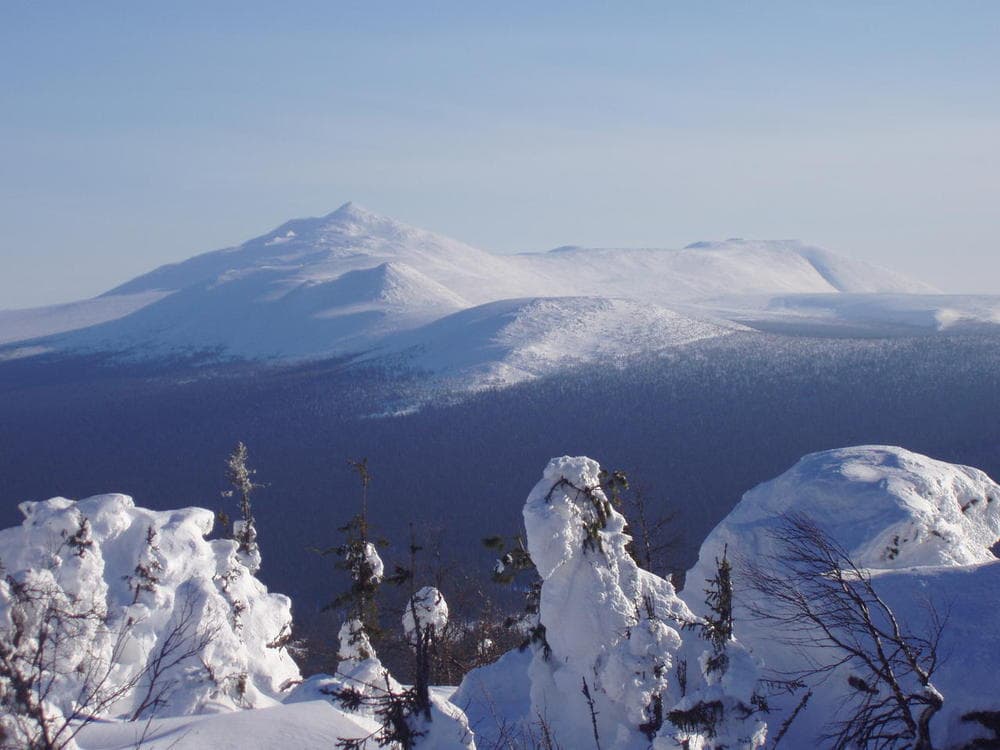
The Basegi Ridge is located in the western spurs of the Ural Mountains . The total length of the ridge is about 30 km. The Basegi name comes from an old Russian word ‘baski’, i.e. beautiful. The ridge features low mountains with gentle green slopes. The peaks are covered with stone placers (or boulder streams), with bizarre rocks, stony idols, arêtes and pillars. In some places, loose rocks form vast stone rivers.
There are relict plants of mountain-forest, subalpine and forest belts as well as subalpine meadows and mountain tundra. The ridge consists of three peaks – Northern, Middle and Southern Basegi . The highest point of the range is Mount Middle Baseg (994 m). In 1982, the territory of the ridge became a protected area of the Basegi Natural Reserve and only Northern Baseg (951 m) is officially open for tourists. There is a trail from the cordon Northern Baseg to the top of the mountain. When you go up, all the high-altitude belts show their secret treasures, animals feel free in the forests and not that afraid of a human. You can even meet a bear.
On a good clear day, you can see Middle Baseg and Southern Baseg , Oslyanka Mountain , the Kharius mountain range, Kachkanar, and provided the visibility is good, even the massif of the Konzhakov Stone.
In summer, the most common activities are hiking, cycling and hiking combined with some rafting on the Vilva or Usva rivers. In winter, there are ski and snowmobile expeditions.
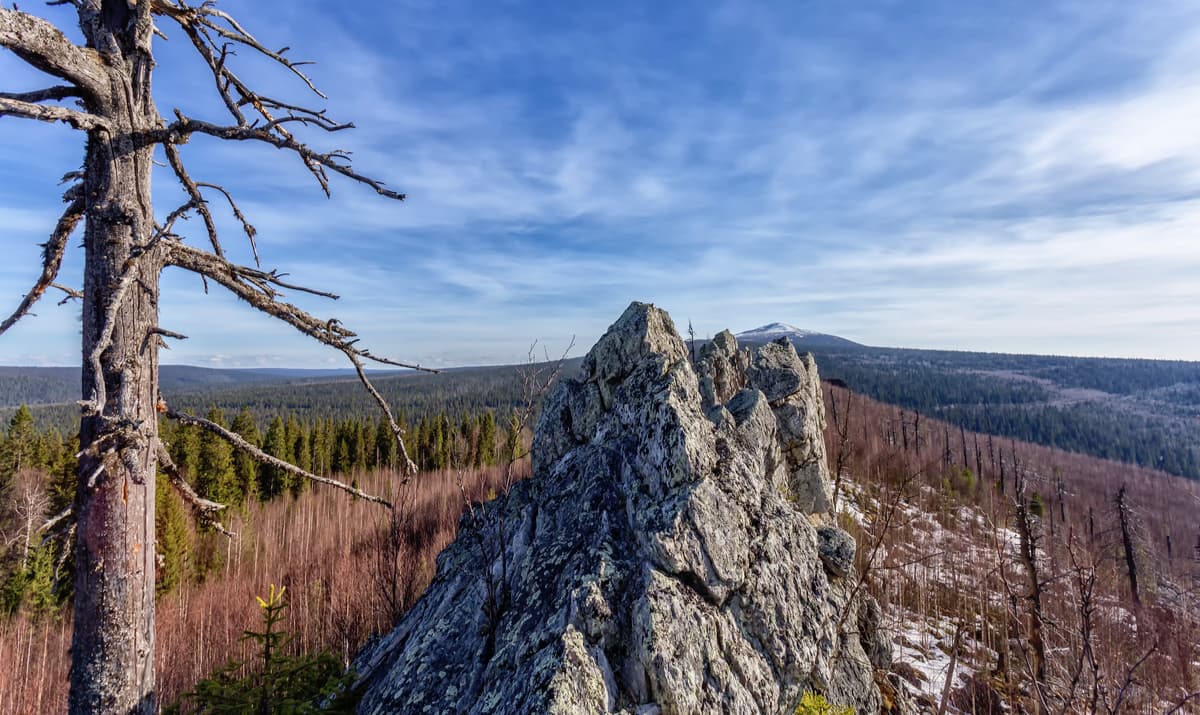
Kolpaki Mountain (614 m) is a hill with an almost perfectly rounded peak. Rumour has it, the name was given because of this round shape as it means ‘a cupola’ in Russian. The main landmark of the hill is the jagged array of stone pillars on the top, the so-called weathering columns of fanciful forms (up to 20 m high). The second name of the mountain is Long Fingers. The most famous of these rocks is the Devil’s Finger. A wooden staircase leads to the observation deck on one of the pillars, you can also have a picnic there. From the top, there is a magnificent panorama over Kachkanar Mountain, the Basegi Ridge, and some gold mines. A pine forest densely covers the slopes. There are a lot of tourists here at any time of the year, mountaineers often have training.
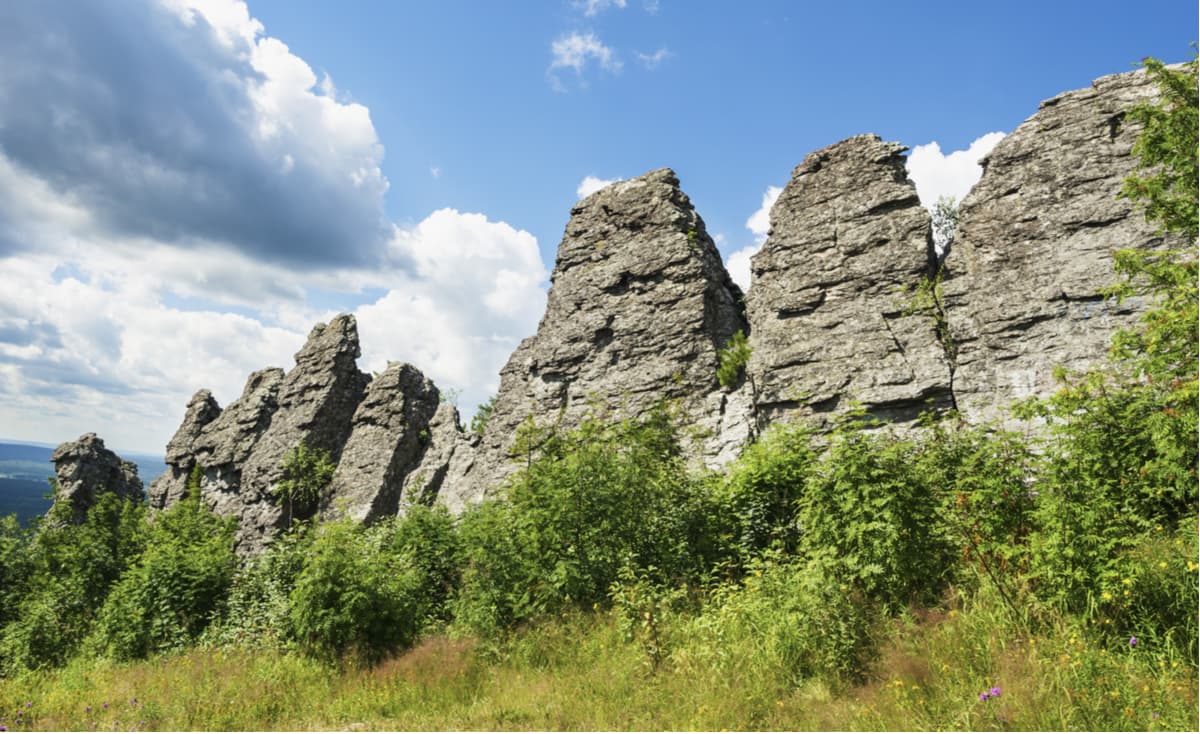
Mount Oslyanka (1,119 m) is somewhat reminiscent of a ridge shape since it stretches from north to south for almost 16 km. The mountain has stone placers, steep slopes and a plateau with stone pillars. It has several peaks, the main is located in the central part of the so-called ‘ridge’ and has a conical shape. In the olden days, the mountain was surrounded by prison camps. Now they are gone giving a way to tourists and outdoor enthusiasts who are lured by the strange shape of this mountain.
Every year in late February or early March a ski marathon is held on Mount Oslyanka . At the end of spring and in summer, you can hike to the top and combine it with good rafting on the Kosva River. From the top, you can see the Basegi Ridge and Konzhakov Stone. Oslyanka is a disputed territory because some researchers attribute it to the Northern Urals whereas others claim it to belong to the Southern Urals, especially since the border between them is quite conventional. But the climate and the nature of the mountain is typical for the Northern Urals. In winter, there is much snow and frequent severe frosts; there are avalanches on the slopes. In summer the weather is very changeable and you can experience massive heat waves alternating with heavy rainfalls.
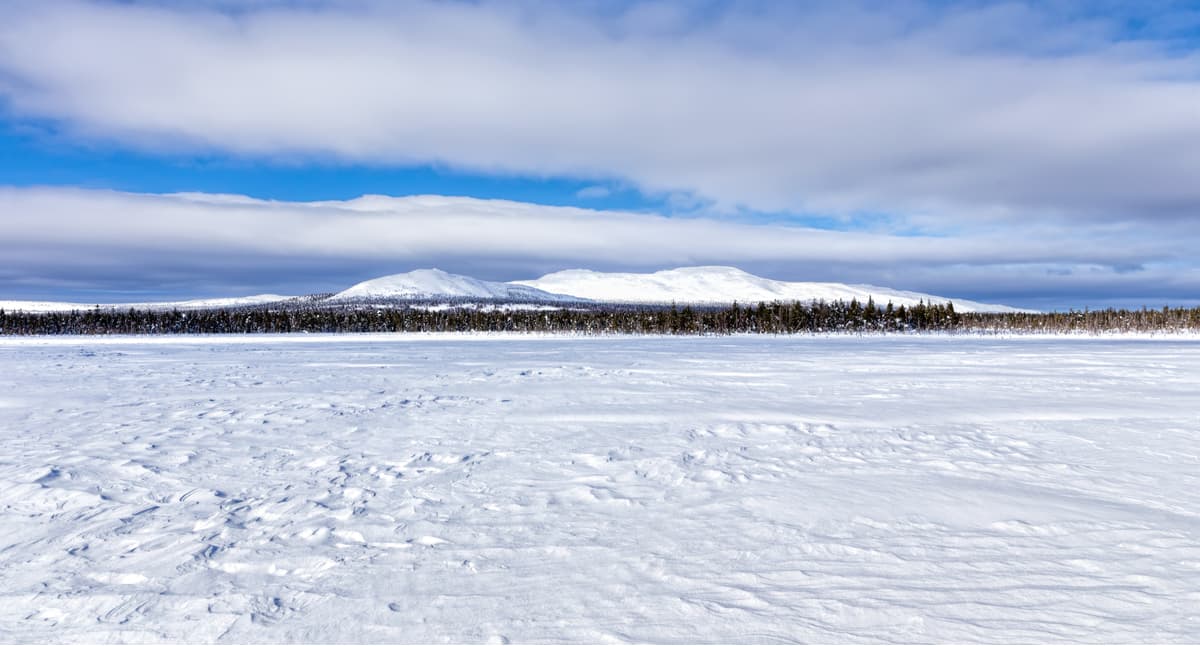
There is a real Stone Town situated near the village of Usva on the top of the Rudyan Spoy Ridge (526 m). This rocky town is also called a Fortress, a Devil's Hillfort or Turtles. When you look at the rocks here, they give an impression of a perfectly organized settlement. You can see narrow streets, corridors, arches and stone gates, houses and squares. This site reminds not of the ruins of a man-made ancient city, but of a kind of a rock labyrinth made of huge boulders. It can also be said that there are townspeople or representatives of the ancient settlement: the stones of the Small and Big Turtle, the Feathered Guardian, the Seal, various stone idols, etc. These rocks have a variety of different colors ranging from white and yellow to red and black, which is due to the sandstones encrusted on the surface of boulders. The Stone Town is divided into a Big Town and a Small Town standing somewhat 200-300 meters apart. There are only four stone idols in the Small Town. Many tourists, including rock climbers, come here at any time of year.
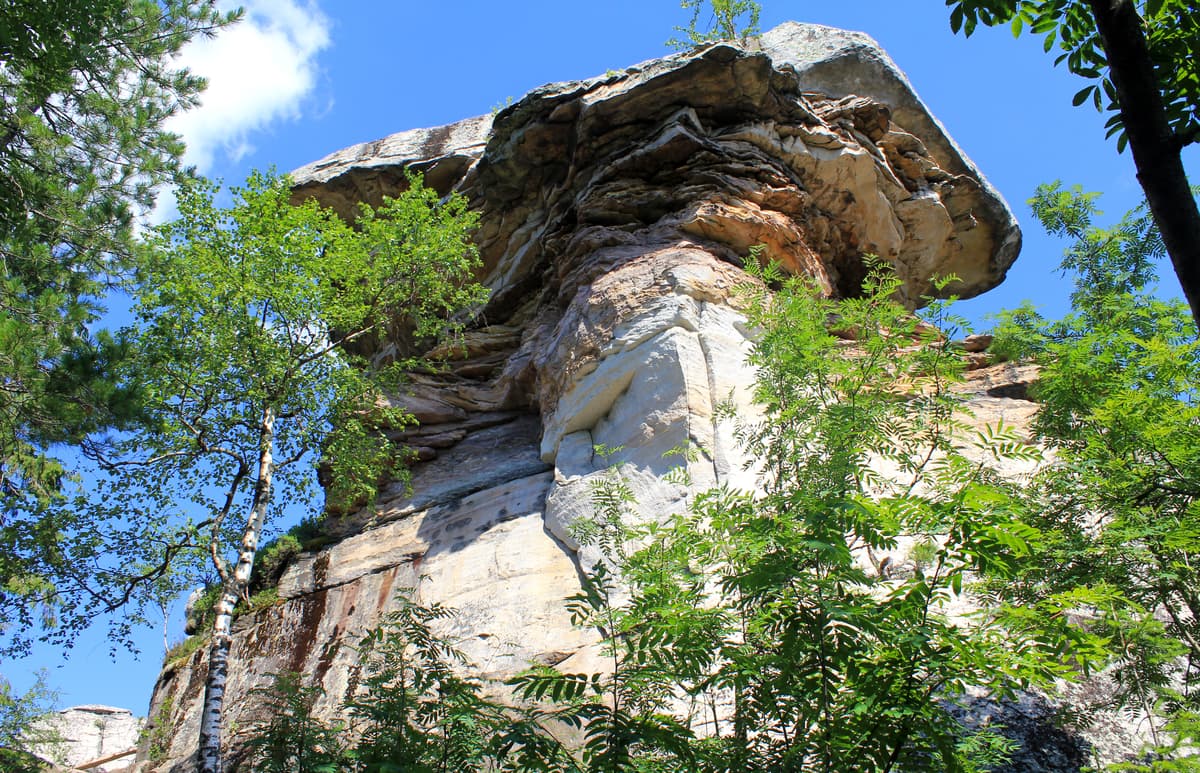
In recent years, the Perm Territory has created quite a few skiing bases, the largest and most famous of which is Gubakha located on Mount Krestovaya (471.3 m). The mountain is the symbol of the town of Gubakha nestled at the northern end of the Rudyan Spoy Ridge.
The List of ski centers in order of their remoteness from Perm City:
- Ivan-Gora (Gamovo village, 20 km from Perm)
- Zhebrei (Zhebrei village, 30 km from Perm)
- Glushata and Mountain (village Glushata, 30-32 km from Perm)
- Polazna (Konstantinovka village, 45 km from Perm)
- Yelniki (Dobryanskiy region, Yelniki village, 50 km from Perm)
- Uval and May Mountain (Krasnokamsk, 50 km from Perm)
- South Kamskie Gorky (South Kamskiy village, 65 km from Perm)
- Firefly and Stalagmite (near Kungur, 95 km from Perm)
- Kalinino (Kungur district, Kalinino village, 100 km from Perm)
- Aleksandrovka (Osinsky district, Novaya Aleksandrovka village, 130 km from Perm)
- Tacman and Ogonyok (Chusovoy, 135 km from Perm)
- Myshchelka (Osinsky district, Podgorodishche village, 150 km from Perm)
- Ashatli-Tulva (between Barda and Chernushka, 180 km from Perm)
- Gubakha (Pervomaisky settlement, 200 km from Perm)
- Sports school (Lysva town, 210 km from Perm)
- Snowflake and New Wave (Tchaikovsky, 260 km from Perm)
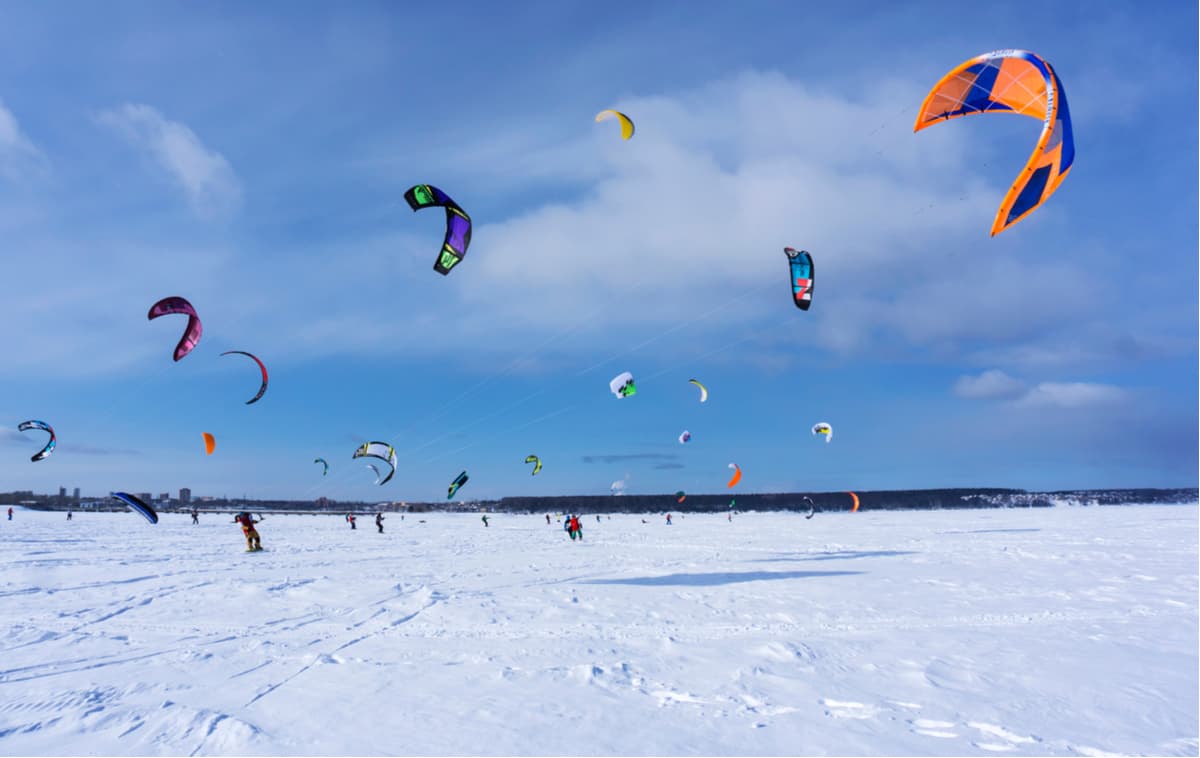
Due to abundant karst phenomena in the region, caves are found aplenty here. Nature was generous and gave the region such gems as the Divya Cave, the Kungurskaya Ice Cave, the Orda Cave, the Miracle Cave and many others. Some of them are equipped for excursions while others preserve their natural pristine state. Each of them is unique.
The Divya Cave is one of the longest caves in the Urals, and the top league the Perm Territory. The name Divya comes from the word ‘divo’, or ‘miracle’ and speaks for itself – it is one of the most beautiful caves in the Urals. The cave is located on the bank of the Kolva River, 12 km from Nyrob village. The total length of all its passages reaches 10 km. A small (about 1.5 m) horizontal entrance to the cave is located in a steep, forested coastal slope of Mount Diviy Kamen at an altitude of 90 m. A very narrow and low corridor leads to a series of grottoes and galleries. You will have to creep on your stomach in some places. In the cave, there is an amazing variety of calcite formations, it feels as if you are in a speleological museum. The cave is quite dry and clean despite a small stream and several lakes. On the surface of the lakes, you can observe an unusual phenomenon – the so-called calcite ice particles. The water temperature in the lakes is +4 degrees Celsius (+39 F) at any time of year. The air temperature in the cave varies from +4 to +8 degrees Celsius (+39 to +46 F).
The Kungur Cave is the oldest tour-guided gypsum cave in the world, the first excursions were here back in 1914. It is known and famous far beyond Russia for its ice grottoes. It is a real underground museum which has paths and lighting allowing you to see the cave in full splendor. There are about a dozen of the caves well-equipped so well in the whole world, thanks to which the Kungur cave is widely known outside the Urals. The entrance to the cave is located on Ice Mountain (Ledyanaya) on the right bank of the Sylva River, on the outskirts of Kungur in the village of Filippovka.
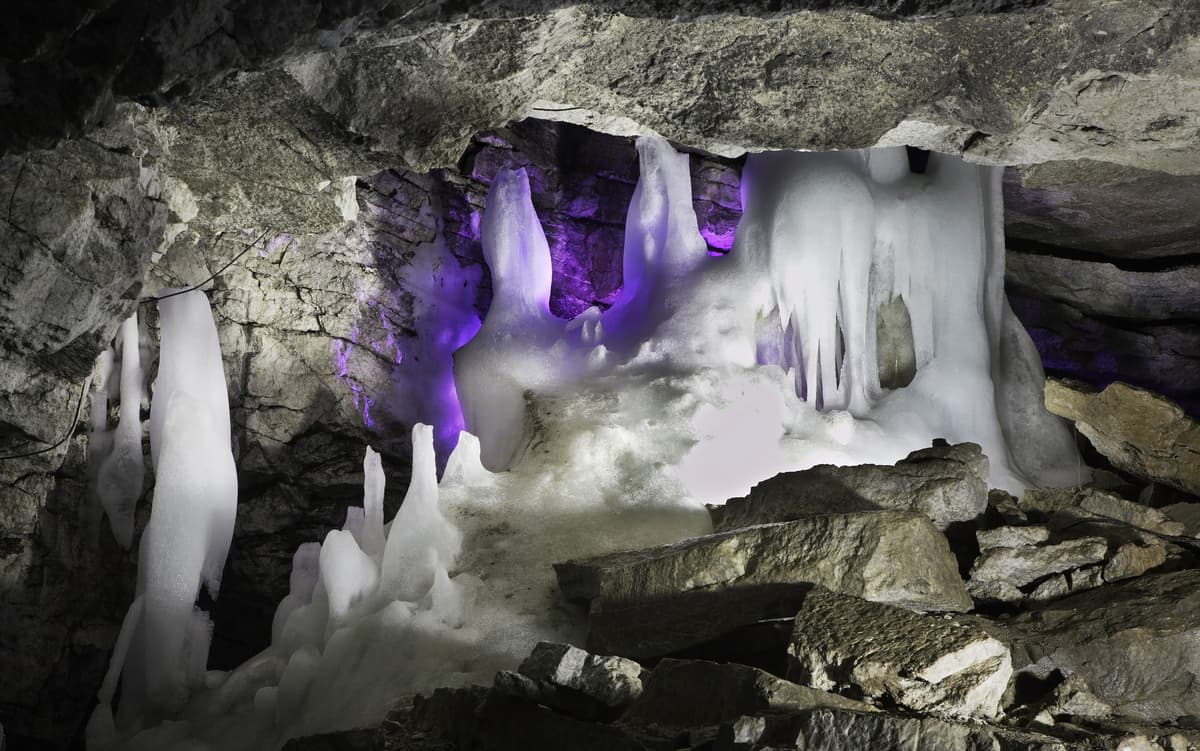
Ice Mountain is strewn with karst sites, there are funnels, sinkholes, karst trenches and many more. One of these is the Kungur ice cave which is about 5700-meter long. About 1300 m is available for tourists. This underground realm has 48 grottoes, 70 lakes, 146 organ pipes. It is called an ice cave for a reason. In most grottoes the temperature is around 0 degrees Celsius (+32F), and in some places it drops to - 15 degrees Celsius (+5F). From February to April, the cave is the most spectacular because then you can observe magnificent snow crystals of the Diamond grotto, as well as ice stalagmites and stalactites of the grottoes Polar, Cross, Vyshka. They create an interesting contrast with the unfrozen lakes in the Friendship of the Peoples Grotto and the Long Grotto. In summer, there is a grand laser show held in the cave. When you are in the cave, try to hear the "music" of the underground organ.
Visiting is possible only with a tour, groups are formed on site and enter the cave according to a schedule. There is a Karst Museum in the cave, where you can spend time waiting for the beginning of your visit. In winter, the Ice Mountain offers skiing and bagel riding (Firefly and Stalagmite Ski Centres).
The Orda (Ordinskaya) Cave is located 35 km from the Kungur Cave, near the village of Orda. It is a rather wild rustic cave, not equipped with any facilities, yet it is also quite famous. It is the longest underwater cave in the world in gypsum, which is a real paradise for cave diving (diving with scuba in caves).
It has 4 km of undersea and underwater passages and the longest siphon in Russia (935 m). You can go 15 meters down a good staircase and see only 300 meters of dry passages and halls. And then there are 1250 m of underground lakes which are an irresistible temptation for speleo-divers. At the entrance of the cave, there are beautiful banks of the Kungur River. In the village Orda, there is a local history museum exhibiting a nice collection of coins, watches, samovars, and there is the Prophet-and-Elijah's Church.
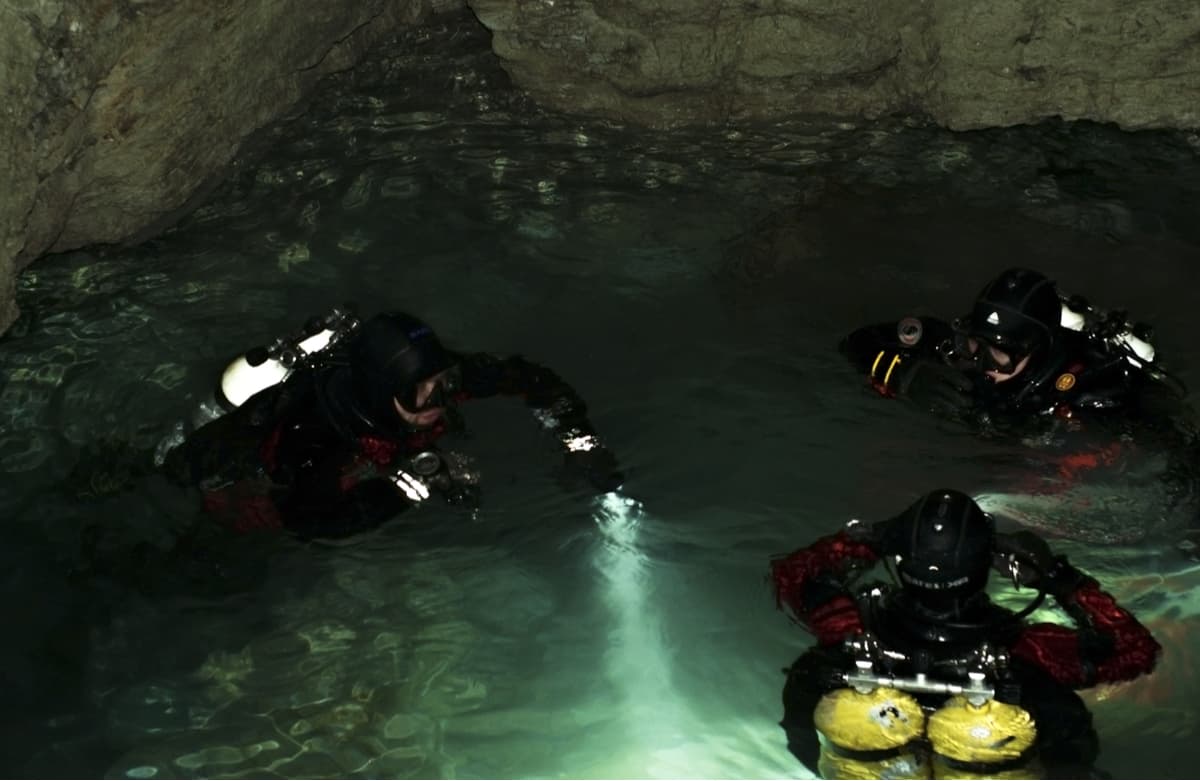
The Miracle or Wonderworker Cave got its name thanks to a lot of bizarre natural creations collected here. It is located on the right bank of the Ponysh River, not far from the place where it flows into the Chusovaya River. The entrance to it is located in a crevice on the slope of Mount Kladovoy Stone (at an altitude of about 50 m). The length of the cave is only 512 m, but the amount of wonderful things is mind-blowing. The walls of grottoes and passages are covered with picturesque limestone formations. Here you can find stalagmites, stalactites, dripstones, small lakes, stone waterfalls, cave pearls, etc. The cave is not equipped, thus you must have some speleological experience or an experienced guide to visit it. The easiest way to go is while rafting on the Chusovaya River. The best time for a hike is July or August. In winter, it is possible to go skiing or snowmobile hiking in the vicinity of the cave.
There are two specially protected natural areas of federal significance in the Perm Territory: The Vishersky Nature Reserve The Basegi Nature Reserve
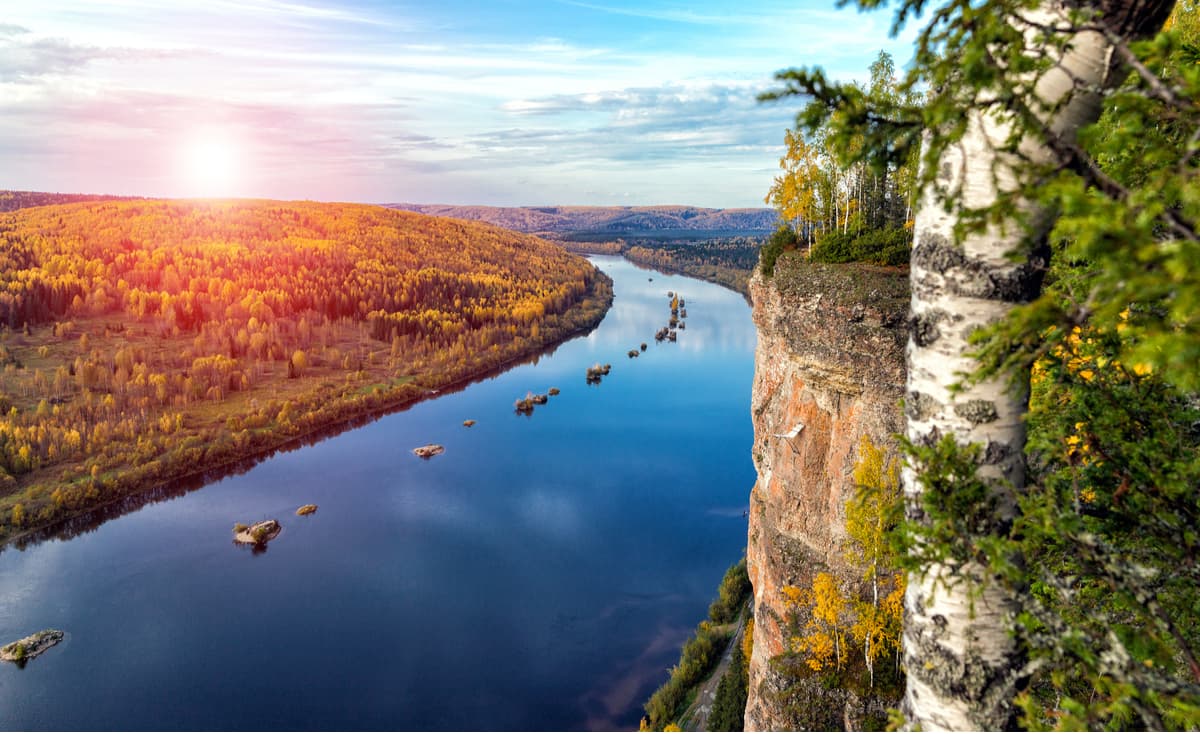
Besides, there are about 300 territories of regional importance and about 130 territories of local importance such as natural landmarks, reserves, protected sites, historical sites, etc.
The richest in natural landmarks is the Cherdyn district of the Perm Territory. There are many specially protected areas here. The following regions are the runners-up: the Krasnovishersky, Solikamsky, Bolshesosnovsky, Chusovskoy.
There is also a private park of the Valley of Waterfalls. Its creator and owner is Anatoly Vasilyev or just Egorych (a local witch doctor, healer, herbalist, author of many books). This park includes a man-made area with many springs and streams, sacred pagan places and an anomalous zone. The Valley of Waterfalls has already become famous as a place of UFO concentration, fluorescent glows of unknown origin and other mysterious phenomena. The visit season is from May to October. You can come here as a tourist or a volunteer.
The Perm Territory is rich in picturesque rivers with beautiful rocky banks, which will be interesting for water tourists and fishing enthusiasts. The most popular places are the Chusovaya, the Vishera, the Usva, the Vilva and the Koiva Rivers.
Most attractive for tourists is surely the Vishera which upper reaches are located in the Vishersky State Nature Reserve.
Apart from its pretty banks and splendid tall rocks towering over it, the Chusovaya River has many caves, Blue Lake, and Small Blue Lake.
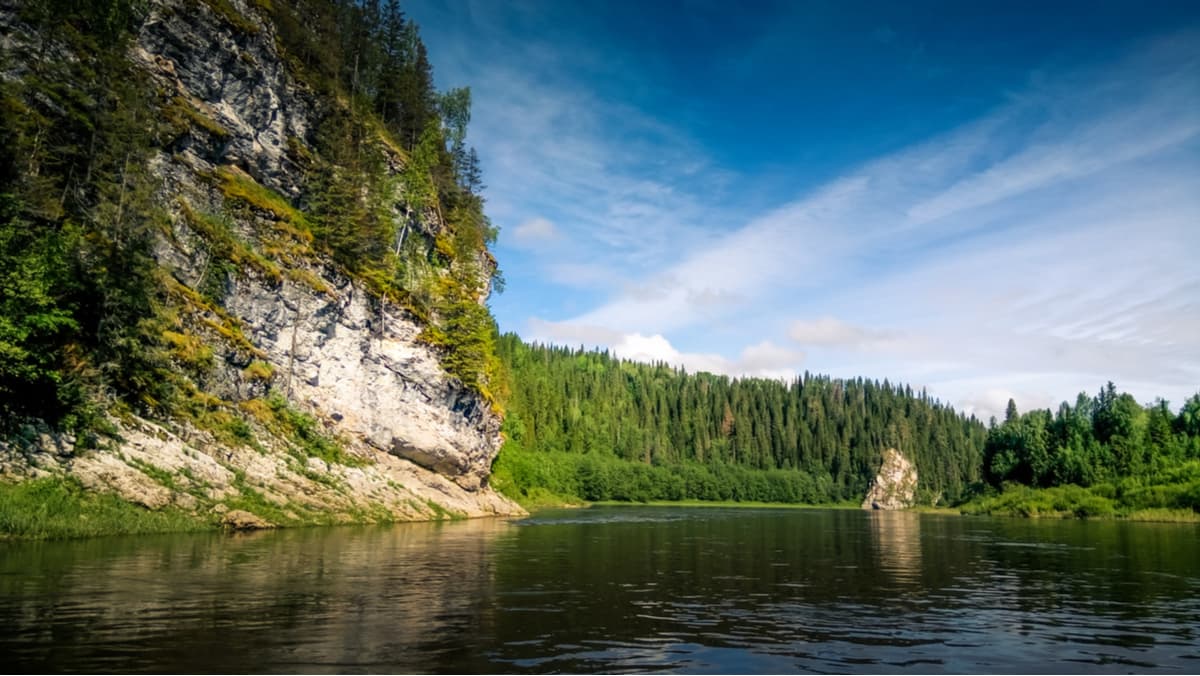
In spring, the Vizhay River, a left tributary of the Vilva River, is one of the most technically challenging rivers for rafting. In summer, it grows shallow and turns into a quiet brook. It starts on the slopes of the Vizhay Mountains . The best time for rafting is late April to late May. The water route starts from the village of Sarany which is 6 km away from the railway station Lucky. The water will not let you relax – sharp underwater and surface rocks are generously strewn along the way. In the coastal rocks, there are plenty of yet unexplored caves. When approaching the village of Pasha, rafting becomes easier, the river expands and forms some islands. However, it is here that the main obstacle of the Vizhay River, the Pashiya Cliff, is located. At the bridge after it, many tourist groups finish their rafting. However, if the rafting continues until Chusovoe village (another 70 km), you can see two more signature phenomena of the Vizhay River: the Big Funnel Rocks and the Great Pasha Cave located in the mountain nicknamed the Alpinist by tourists. The entrance to the cave is 30 m above the river. The 500-meter-long cave has 15 grottoes and a 12-meter waterfall that turns into a stream flowing into the underground lake.
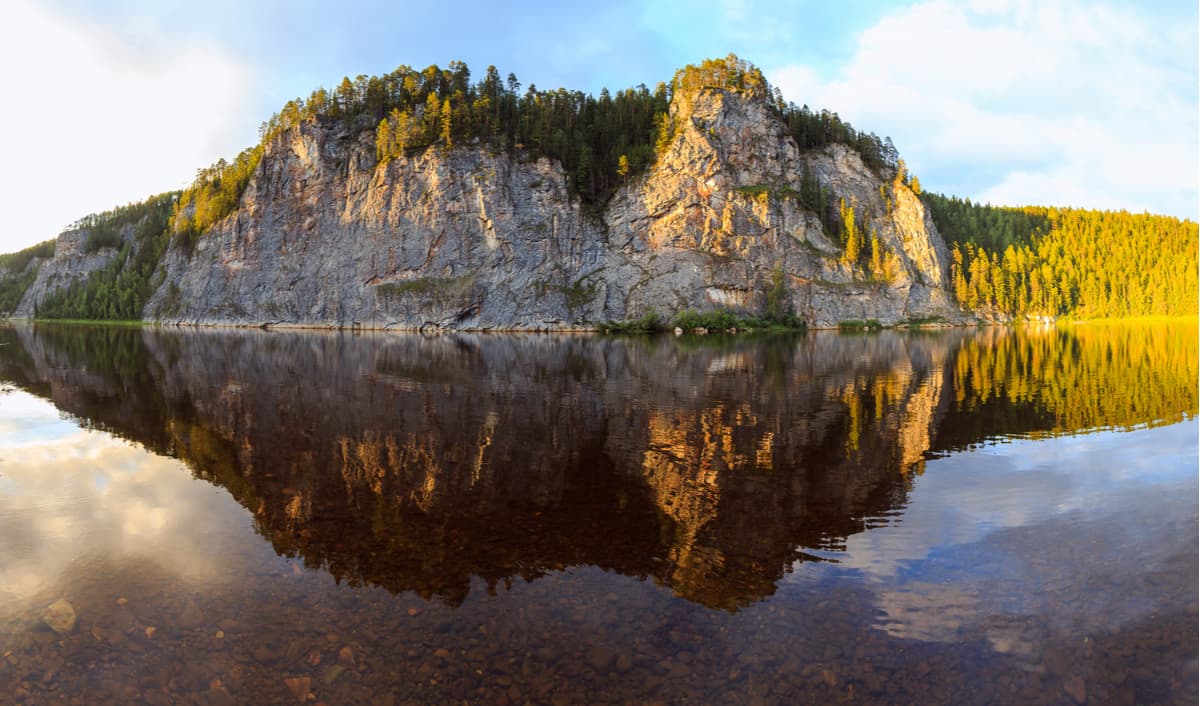
Rafting the Vilva River is a real test of your rafting skills as it is a truly mountain river. The river is located in the north-east of the Perm Territory and flows down the western slopes of the Ural Range. In springtime, right after the ice drift, the river becomes one of the fastest and most fertile in the region. In summer, the river shoals heavily in the upper reaches. Only well-trained rafters or those with an experienced guide can go down it. The river bed is full of turbulent places, rapids, rolls and swifts.
The main obstacle is a series of rapids called Nyrky. There is a dangerous artificial threshold created on the site of the gas pipeline crossing, there is a reinforced concrete pole and the difference in height reaches 1.5 m, which is better to bypass by land in case you are not sure you can master it safely. You can start rafting from Novovilvensky or a bit farther away from the mouth of the Korostelevka River. After the Nyrky rapids and before the Koldovaty (Sorcerer’s if translated poetically) brook, the Vilva flows past the Kosaya Plate Rocks. Beware of those since the riverbed in their vicinity features many rocks, boulders and rapids. Once you pass the mouth of the Koldovaty brook, you come into the Koldovaty rapids. Farther down the stream, there are more rocks in the river, e.g. the Upper Baran and the three Morozovsky islands after the confluence with the Izbnaya River.
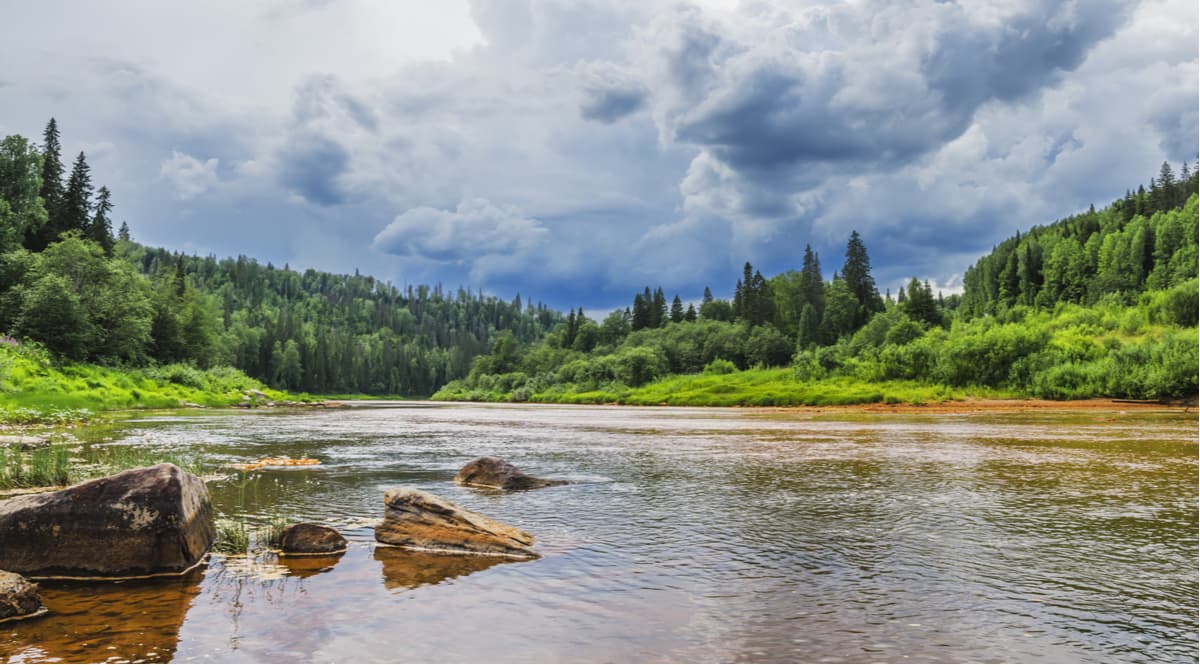
There is a picturesque bridge near the uninhabited village called Palace, and just in front of the village there is a picturesque Falcon (Sokolnaya) Mountain. It is an ancient volcano of about 600 million years old. Such geological formation is a rarity for the Urals. One can climb the mountain and admire the views of the Basegi Ridge and the river. The trails are heavily covered with shrubs and plants, hardly anybody gets here. After the Palace village, the Vilva River features fewer obstacles and islands. In the lower reaches and especially after Gremyachinsk town, the river is heavily polluted and becomes almost lifeless due to rampant industrial activities. The Vilva finally flows into the Usva and further into the Chusovaya River.
The Koiva River is considered the most picturesque tributary of the Chusovaya River. It enjoys crystal clear waters and is mainly mountainous, winding and narrow in its upper reaches. The Koiva has many rapids and a fast current. It is rafted mainly during the spring floods (in the first half of May). In summer, the river is shallow, but despite the fact that the speed of the current is dropping, it still remains passable for both kayaks and catamarans. However, during dry weather there may not be enough water for rafting (above the Biser village). Rafting the Koiva is technically more complex and interesting in spring, whereas in summer, even families with kids can do it. The route can be combined with the Chusovaya River rafting.
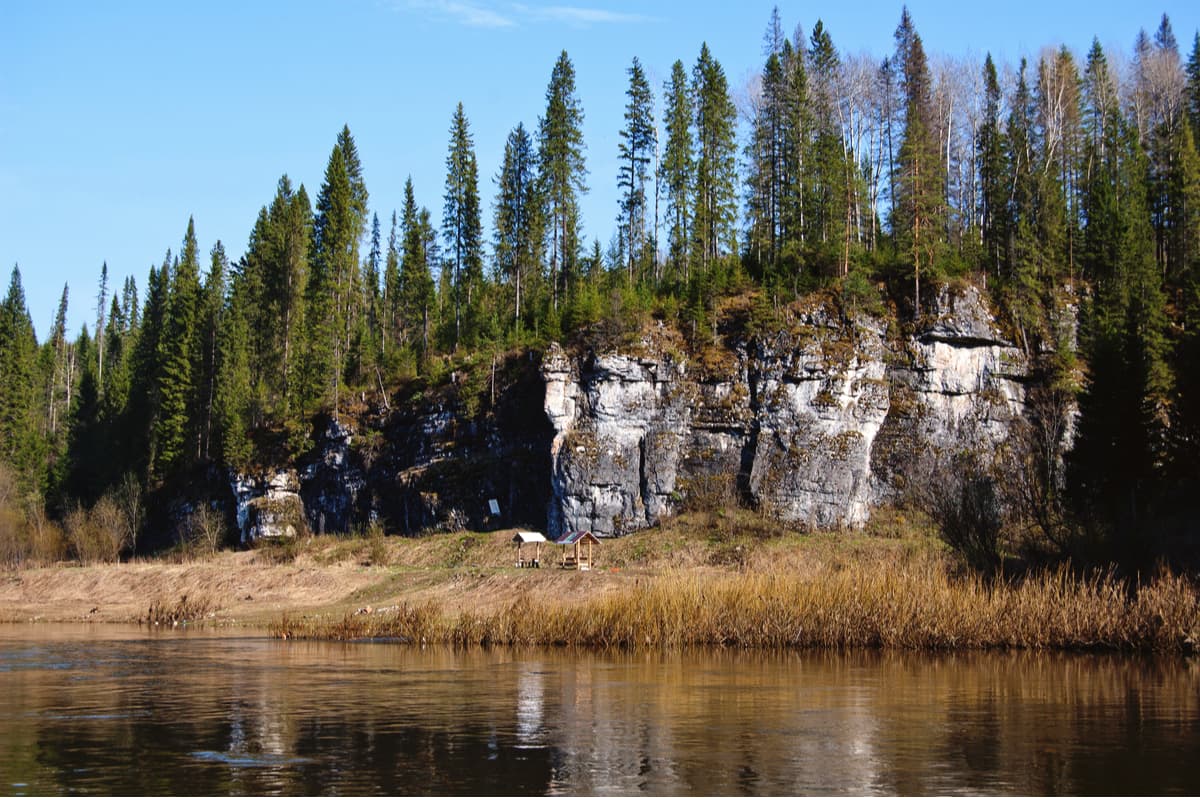
The trickiest part of the route is from the village of Old Biser to the village of Kusya -Alexandrovsky. It features the Fedotovsky threshold (heaps of boulders across the river that allow only for a very narrow gentle water drain in the middle; the threshold is not dangerous in summer), the Kalistratovskaya Shivera (it is a 500-meter long rapid, but not dangerous). Once you pass Ust-Tyrym village, there are several beautiful rocks some of which can be easily climbed (Strelny, Arochny, Dyrovaty). The Shaitan rock is fascinating as well. Near Kusya-Alexandrovsky settlement, there is a waterfall formed by the dam of the Kusya river that dumps excess water into the Koiva river. In spring, extreme sports lovers conquer the waterfall on catamarans. There is a road bridge downstream where many rafters finish their joy rides. Further downstream, before the Koiva flows into the Chusovaya River, there is a section with many artificial islands. There are quite a few stops along the banks of the Koiva River, and the river is popular with both rafters and fishing enthusiasts.
The Usva River is the largest tributary of the Chusovaya River. It originates on the eastern slope of Mount Khariusny Stone. The valley of the river is winding, but at the same time the river is quite calm. There are about 200 rapids which probably prompted the Komi people to call it ‘noisy water’. There are rocks along its banks. Rafting is done with catamarans and kayaks. The optimum time for a ride is when the water is still high and that is in the beginning of May, but you can go rafting all summer. It is necessary to keep in mind that in summer the river grows very shallow and only the lower section from the village of Usva to the Chusovaya river is available for boating.
There are several options of routes along the Usva. You can start rafting from the station Usva or from the village Srednaya Usva. You can finish rafting in different spots depending on the desired length and time of the route. At first, the river is narrow, only up to 5 m wide, heavily looped, and the current is fast. However, once the right tributary called the Bolshoi Yaz flows into the Usva, the river straightens and becomes calmer.
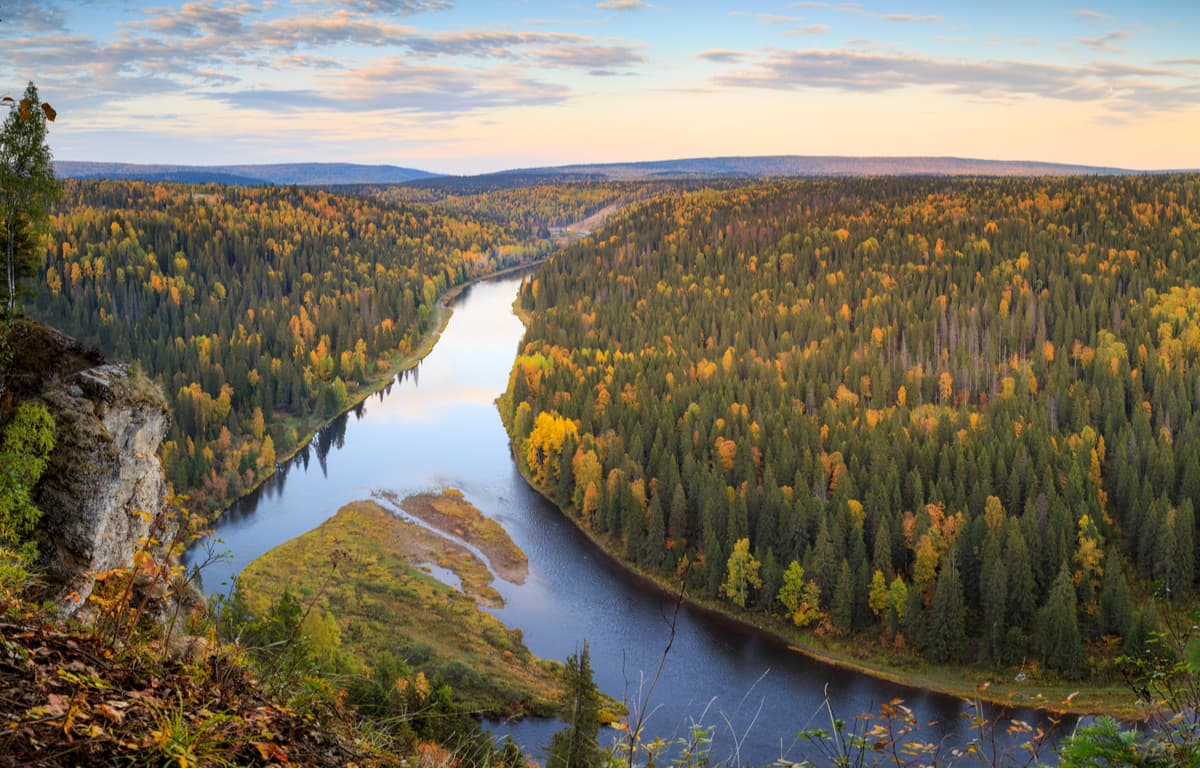
Close to the next right tributary called the Persha and after the destroyed bridge, there is a beautiful view of the North Baseg Mountain. Not far from this place is the border of the Basegi Nature Reserve . When you do downstream, there are rocks with equipped observation platforms from which you can admire the beauty of the mountains and panoramic views of the river. Then begins the most difficult part of the rafting – the Dry Rapids. For several kilometers, the riverbed features rocks and boulders occupying most part of the river. In summer during a drought, they turn into piles of stones, hence the word "dry" in the name of the rapids.
The section from the village of Srednaya Usva to Bezgodovo (about 130 km) lacks housing and roads, all you see is solid taiga and pristine nature. Several purest rivers flow into the Usva, i.e. the Big Khariusnaya, the Little Khariusnaya, the Big Baseg, the Little Baseg. This span of the route is a paradise for fishing enthusiasts. While rafting, drop to Gromovaya village and see some stone pillars (all lonely rocks along the river Usva are called pillars). There are 4 easy rapids from Shumikhinsky settlement to the station Usva. Three kilometres away from the village of Usva, the river has majestic rocks that stretch for several kilometers – this is the Usva Columns Massive; these rocks are up to 120 meters tall and you can see traces of corals in them, which proves there used to be a sea here a million years ago.
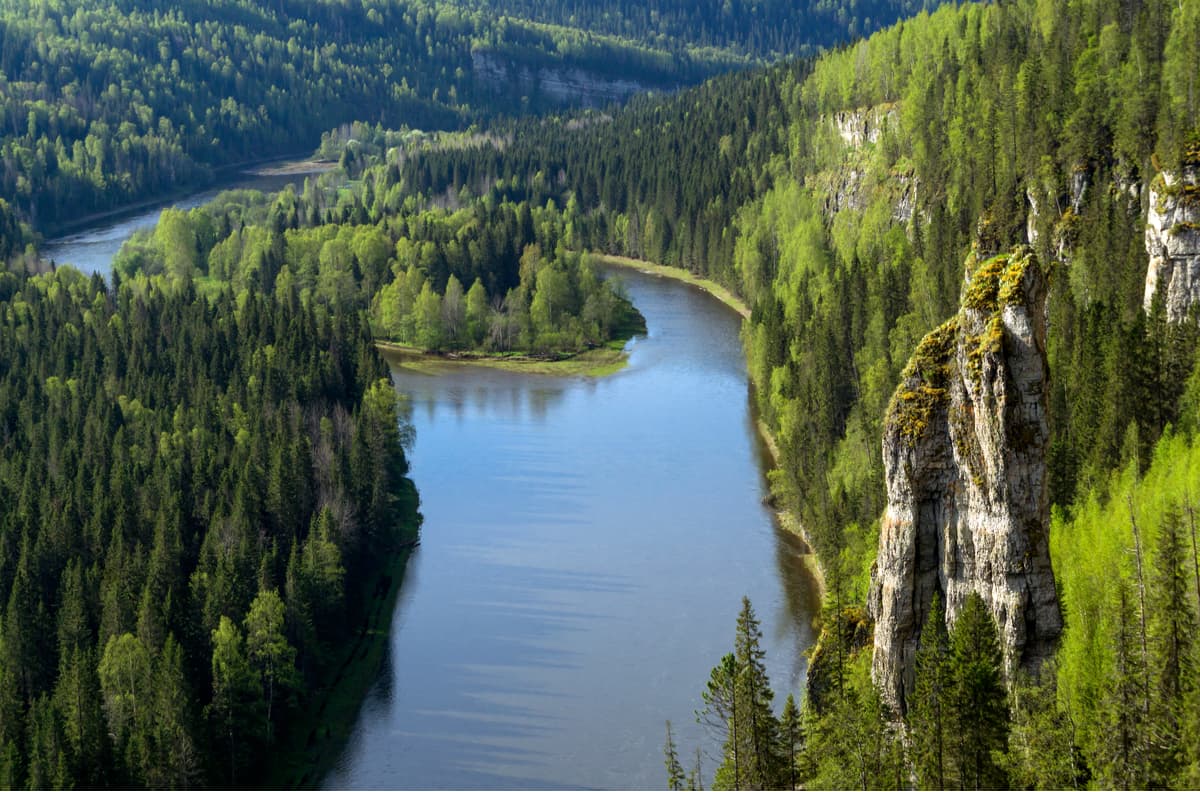
Once you pass those columns, the wonders don’t stop. There are mountains and rocks on the banks of the Usva, i.e. Overhanging Stone, Small and Big Log Stones (famous for their echos), Panorama Rock, Goat Stone (aka Strelny), Omutnaya Stone (aka Big Whirlpool). At Omutnaya Stone, the river depth reaches 6 meters, the water here is very cold even in summer because of the abundance of underwater springs. Then there are the Bastion cliffs and the Arch. You can finish the route in Chusovaya village where there is a railway station and access to automobile roads.
Another attraction of the Perm Territory is the Ice Falls called the Icicle. In spring and summer, 12 km from Usva railway station, on the right bank of the river Usva, streams and brooks flow down from Omutnaya Stone forming mini waterfalls about 5 m high. However, at this time of the year they are not very remarkable among dozens more similar cascading streams in the Urals. Quite a different thing happens in winter. The water freezes and turns those smallish waterfalls into a giant icicle 15 to 27 meters high. Every winter its size and shape is unique. The Perm people call this icefall very simply – the Icicle. The Icicle is not the only frozen waterfall here, there are a couple of smaller cascading icefalls in the region as well.
Alexandrovsk Blue Lakes are located in the north of the Perm Territory near the town of Alexandrovsk. These amazing man-made lakes have deep turquoise water. They were formed in the old abandoned quarries used for limestone mining (the Shavrinsky and Morozovsky quarries). It is the limestone dredge in the water that gives it such a beautiful color. You can get to the quarries by bus from Perm.
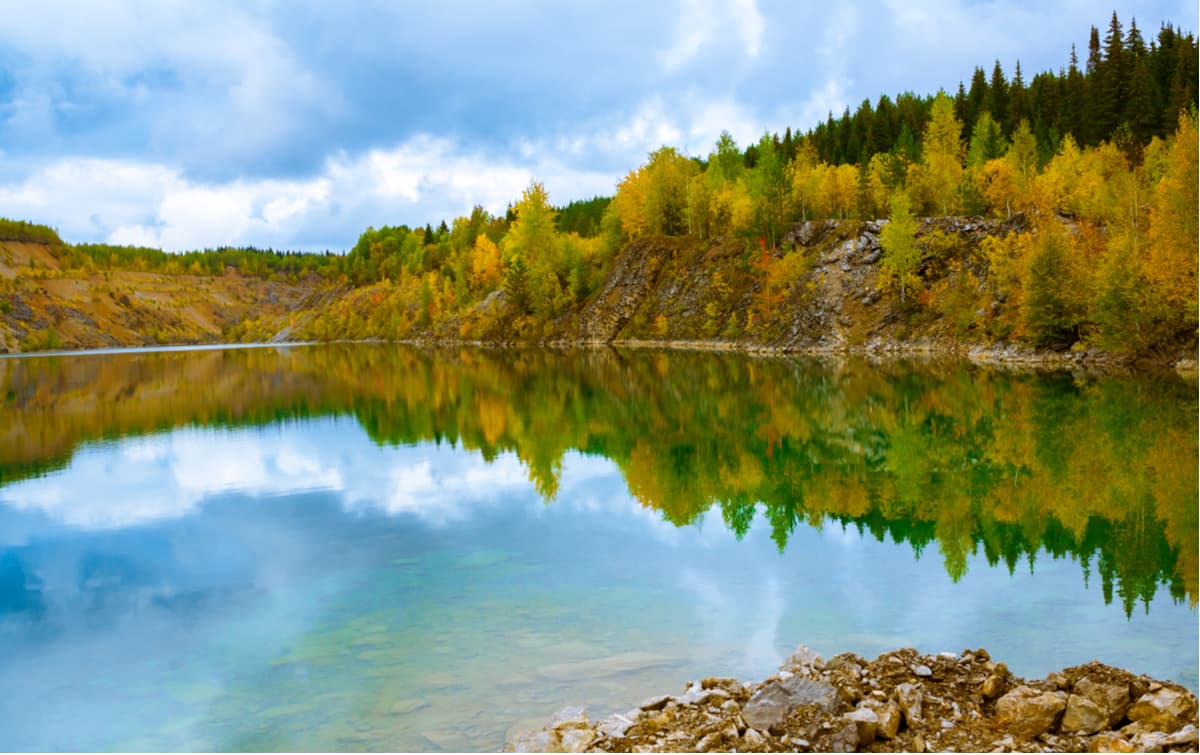
The White Sea in Berezniki is another unusual place in the Perm Territory that exhibits a striking contrast of landscapes. Just imagine walking in the forest, looking at giant trees and catching a glimpse of the Kama River now and then. But suddenly you step into a place when you see a turquoise surface of water resembling some tropical sea with a snow-white shore around it. In the background, you can see the factory buildings. This is Berezniki Soda Plant. The city of Berezniki is home to the soda industry in Russia. When soda is produced, the generated waste is a kind of pulp that is stored in a special storage facility. The White Sea is nothing but a pulp storage reservoir filled with water. The white color of the pulp gives the shores this whitish hues of a true tropical sea shore, and the azure color of the water is produced by various chemical compounds. You can get to the White Sea by bus from Perm to Berezniki. From the center of Berezniki, you should take a bus to the town of Usolie or Usolie district (go to the Boat Base station).
The following zoological nurseries operate in the region: The Cossack equestrian school, which includes a mini zoo and a horse farm. It is situated 140 km from Perm. An ostrich farm called The Strauss Park (50 km from Perm).
The best place to start your acquaintance with the Perm Territory is its capital – the city of Perm. The transport network here is well-developed. There is the Perm branch of the Sverdlovsk Railway, the Kama River Shipping Company, the Bolshoye Savino International Airport, and major roads connecting Perm to Moscow.
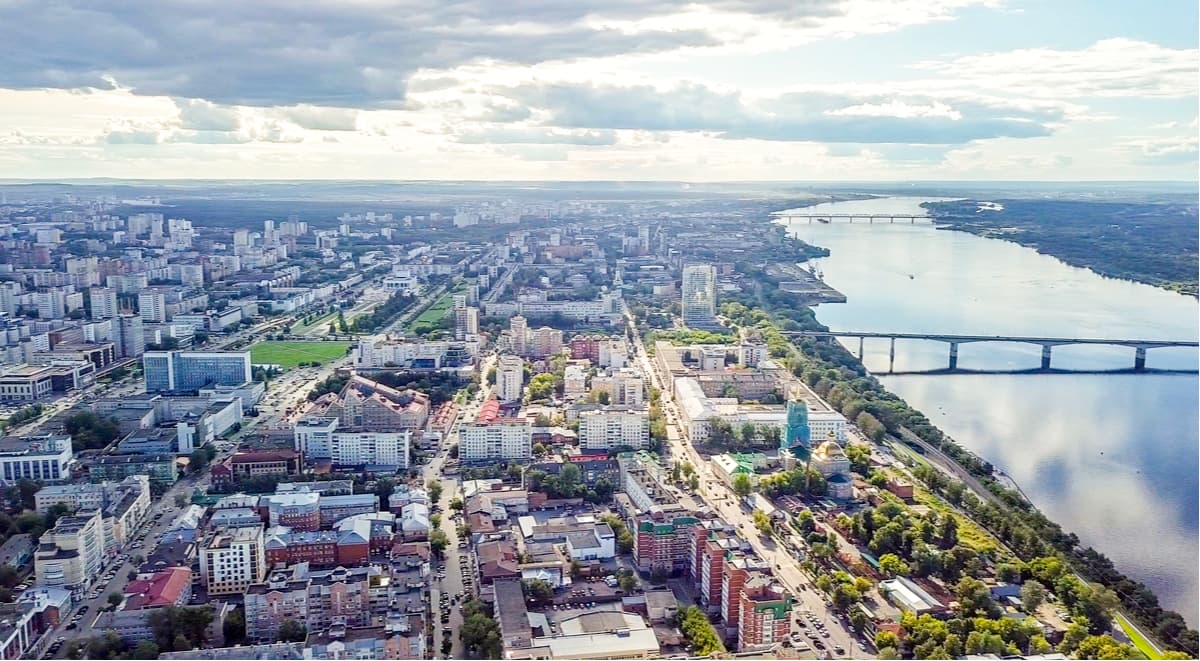
It is most convenient to get to the city of Perm by rail or by air.
Perm was founded in 1723 by Vasily Tatishchev, the man who laid foundations for many cities in the Urals. The city began as a small settlement at Yegoshikhinsky Copper Smelting Plant. Take a 2-hour walking route called The Green Line to acquaint with the city. Along the route, there is a green line on the road, and information boards near interesting sites.
Perm is located at a large waterway. Walk along the embankment of the river Kama, go to the Kommunalny bridge which is especially beautiful in the evening lights, and ride a river tram.
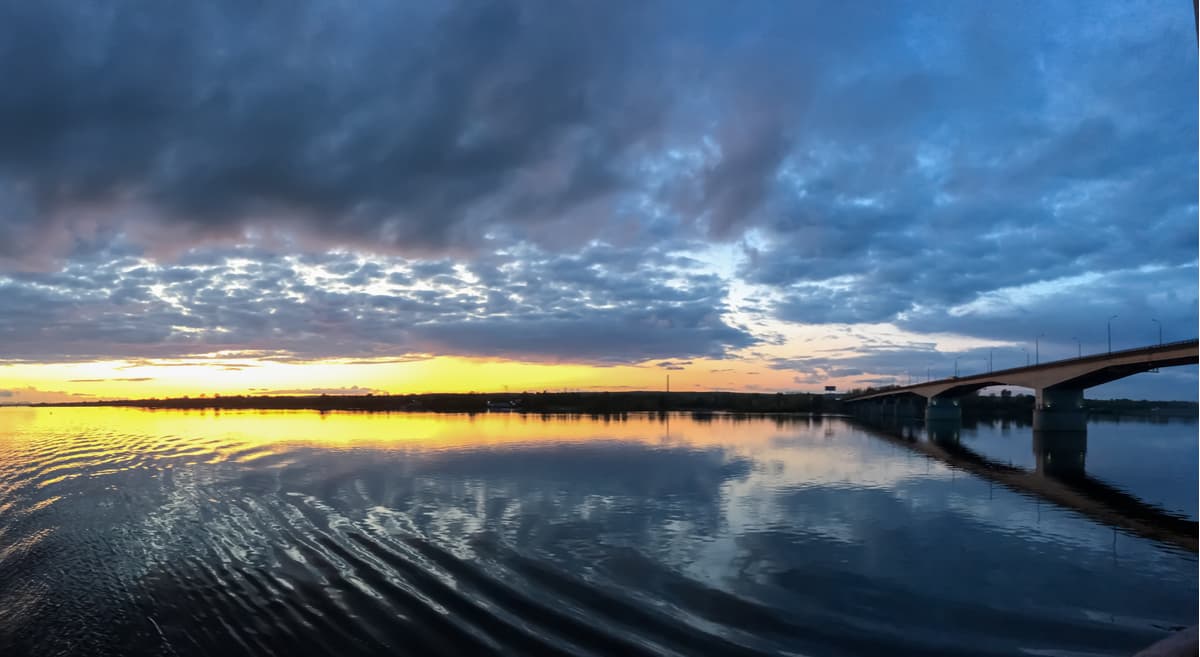
There are several museums in the city, e.g. Perm Art Gallery, Regional Museum, Museum-diorama December 1905 armed uprising in Motovilikha, PERMM Museum of Modern Art.
During the theatre season, you can go to one of the theaters: Perm Academic Theatre of Opera and Ballet named after P.I. Tchaikovsky, Theatre Ballet of Evgeny Panfilov, Perm Academic Theatre called Theatre-Theatre, and Perm Municipal Theatre At the Bridge.
There are many other interesting sights in the vicinity of Perm City. The most famous of them are
- The Architectural and Ethnographic Open Air Museum Khokhlovka (46 km from Perm)
- PERM-36 Memorial Museum (112 km from Perm). The only museum of political repressions in Russia. It is a former colony for political prisoners who served their sentence here during Stalin’s times.
- The Chusovaya River History Ethnographic Park (120 km from Perm). It is a fairy-tale place at the foot of Arinina Mountain. The park has kids’ skiing school of the Olympic reserve.
- Molebskaya anomaly zone, the locals call it Molebka (170 km from Perm). It is a local Bermuda Triangle, a kind of a mysterious place where you can observe unusual phenomena, including UFOs, various airglows and other interesting and strange phenomena.
- The Museum of Salt History in Solikamsk (213 km from Perm) which shows how salt was produced from the 17th to the 20th century in Russia. There is the only fully preserved salt plant in Russia which houses a museum as well.
Explore Perm Krai with the PeakVisor 3D Map and identify its summits .

PeakVisor Hiking Maps
Be a superhero of outdoor navigation with state-of-the-art 3D maps and mountain identification in the palm of your hand!
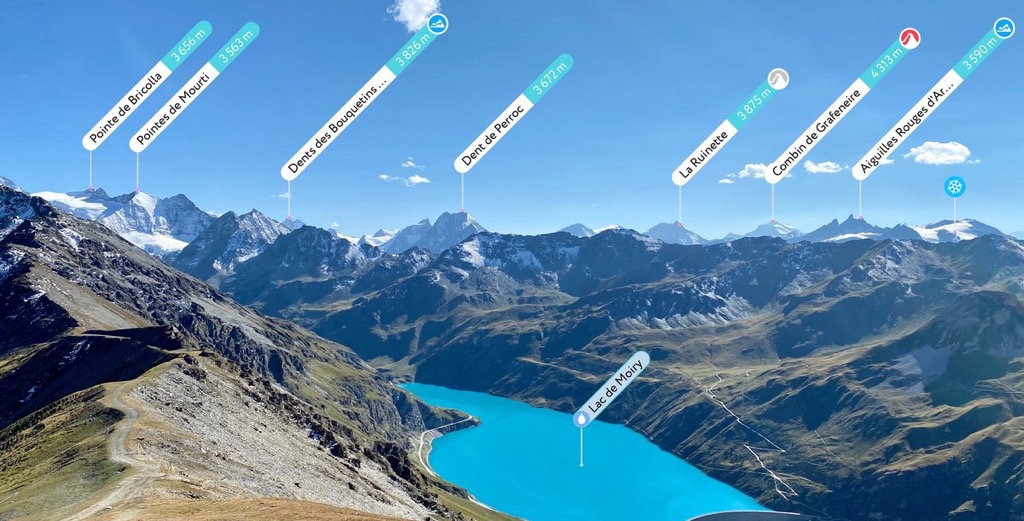

Image Unavailable

- To view this video download Flash Player
Mountain Warehouse Mini Trek 6L Backpack – Unisex Small Hiking Bag Black
- Capacity - 6 litres, for walking, daily commute and day trips
- Multiple pockets - two side mesh bottle pockets, 1 large compartment and 1 inner pocket
- Ripstop fabric - Stops rips, heavy duty fabric and longlasting
- Dimensions - 29.5 x 23.5 x 14 cm

Customers also viewed these products

PRODUCT CERTIFICATION (1)
Carbonfree Certified determine the carbon footprint of the product, and associated carbon emissions are offset with reduction projects.

Product information
Product description.
The Mini Trek 6 Litre is a small but tough rucksack for day trips and walks. Durable and lightweight, the bag has multiple pockets for storage and reflective piping for better visibility in the dark. Active use - features a front elasticated cord for holding helmets or other light goods Multiple pockets - two side mesh bottle pockets, 1 large compartment and 1 inner pocket Ripstop fabric - stop rips in their tracks with this heavy duty fabric Dimensions - 29.5 x 23.5 x 14 cm Ref: 016351.210914
Looking for specific info?
Customer reviews.
- 5 star 4 star 3 star 2 star 1 star 5 star 64% 18% 7% 3% 8% 64%
- 5 star 4 star 3 star 2 star 1 star 4 star 64% 18% 7% 3% 8% 18%
- 5 star 4 star 3 star 2 star 1 star 3 star 64% 18% 7% 3% 8% 7%
- 5 star 4 star 3 star 2 star 1 star 2 star 64% 18% 7% 3% 8% 3%
- 5 star 4 star 3 star 2 star 1 star 1 star 64% 18% 7% 3% 8% 8%
Customer Reviews, including Product Star Ratings help customers to learn more about the product and decide whether it is the right product for them.
To calculate the overall star rating and percentage breakdown by star, we don’t use a simple average. Instead, our system considers things like how recent a review is and if the reviewer bought the item on Amazon. It also analyzed reviews to verify trustworthiness.
- Sort reviews by Top reviews Most recent Top reviews
Top reviews from the United States
Top reviews from other countries.
- Amazon Newsletter
- About Amazon
- Accessibility
- Sustainability
- Press Center
- Investor Relations
- Amazon Devices
- Amazon Science
- Sell on Amazon
- Sell apps on Amazon
- Supply to Amazon
- Protect & Build Your Brand
- Become an Affiliate
- Become a Delivery Driver
- Start a Package Delivery Business
- Advertise Your Products
- Self-Publish with Us
- Become an Amazon Hub Partner
- › See More Ways to Make Money
- Amazon Visa
- Amazon Store Card
- Amazon Secured Card
- Amazon Business Card
- Shop with Points
- Credit Card Marketplace
- Reload Your Balance
- Amazon Currency Converter
- Your Account
- Your Orders
- Shipping Rates & Policies
- Amazon Prime
- Returns & Replacements
- Manage Your Content and Devices
- Recalls and Product Safety Alerts
- Registry & Gift List
- Conditions of Use
- Privacy Notice
- Consumer Health Data Privacy Disclosure
- Your Ads Privacy Choices

IMAGES
COMMENTS
Mountain Warehouse. £14.99 Save 40%. Now £8.99. Shop great value Rucksacks & Backpacks. Large Rucksacks perfect for travelling and smaller backpacks with laptop compartments.
Mountain Warehouse. $23.99 Save 33%. Now $15.99. Great deals on travel backpacks, rucksacks & daypacks. Shop our range of backpacks to buy online today.
Mountain Warehouse. $99.99 Save 30%. Now $69.99. Great deals on Travel Backpacks, Rucksacks & Daypacks. Shop our range of Backpacks to buy Online Today. Fast Dispatch & Delivery.
Buy Mountain Warehouse Voyager 50L Wheelie Backpack - For Traveling Jet Black and other Casual Daypacks at Amazon.com. Our wide selection is eligible for free shipping and free returns. ... MATEIN Rolling Backpack, 17 Inch Travel Laptop Backpacks with Wheels, Water Resistant Large Roller Carry On Luggage Wheeled Backpack, Trolley Overnight ...
This post is all about the Mountain Warehouse Traveller 60 + 20 Litre Rucksack. The pack has been around for several years, and remains one of the store's most popular backpacks. Designed specifically with travellers in mind, rather than for use by hikers and campers, this pack is PERFECT for long term travel.
Product Description. Two bags in one tough design, the Ultra Traveller 65 + 15L Rucksack is perfect for long treks or going overseas. Lots of space, a fully detachable daypack and made of rip-stop fabric with padding and support where needed. Buy Mountain Warehouse Ultra Traveller 65 + 15 L Rucksack - Breathable and other Backpacks at Amazon ...
The Mountain Warehouse Carrion 65L Rucksack's main compartment has a double toggle closure system on the top so that you can extend the carry capacity; just make sure it doesn't get top heavy and affects your balance (Image credit: Pat Kinsella). I've taken the Mountain Warehouse Carrion 65L Rucksack on various multi-day hiking escapades, including an excellent wild camping trip on Dartmoor.
Mountain Warehouse Traveller 60 + 20L Travel Backpack - for Camping, Outdoor Rucksack with Detachable Daypack Black . 4.6 4.6 out of 5 stars 309 ratings | Search this page . Currently unavailable. ... Large Outdoor Sport Travel Daypack Rucksack for Climbing.
Looking for a cheap and cheerful backpack with a range of features for diverse hiking? The Mountain Warehouse Pace 30L might be for you
These backpacks are designed to be able to hold a substantial amount of kit and will have plenty of pockets for storage. Large rucksacks may also contain a detachable backpack. A 65 Litre backpack, is well suited for trekking and is a popular choice for those taking part in expedition award schemes.
The Carrion 80L rucksack comes with an easily accessible rain cover that covers the rucksack from head to bottom. While we constantly preach for waterproof rucksacks, this is still a cool alternative to waterproofing the material of the rucksack exterior. Here's a full review by Mountain Warehouse Themselves! Adam Sheriff.
7. Mountain Warehouse Voyager Wheelie 50 + 20L. The Mountain Warehouse Voyager Wheelie 50 + 20L takes the above 50L rucksack and adds a 20L day pack to it! Perfect convertible bag for longer trips that require more storage or the use of the backpack and day pack.
Mountain Warehouse Peru 55L Backpack. Visit the Mountain Warehouse Store. 4.4 13 ratings. | Search this page. $8099. Color: Charcoal. Size: One Size. Chest/Sternum Strap - Offers support for your back by helping to distribute weight and balance your pack. Compressions Straps - Used to reduce the weight of the rucksack.
Similar to the Carrion 65 litre & Carrion 80 litre rucksacks, the tor 65l rucksack has a padded back with a purposely designed dent in the middle. This allows for proper ventilation and air to flow to your back. This will ensure you avoid back sweat. Women's Fit. This is an important feature that is loved by all women travellers, hikers, and campers.
Mountain Warehouse. €129.99 Save 40%. Now €77.99. Great deals on Travel Backpacks, Rucksacks & Daypacks. Shop our range of Backpacks to buy Online Today. Have a look at our range & Shop Online Today!
Perm - Overview. Perm is a city located on the territory adjacent to the western slope of the Urals in the east of the European part of Russia, the administrative center of Perm Krai, a transport hub on the Trans-Siberian Railway. It is a large diversified industrial, scientific, cultural, and logistics center of the Urals. The population of Perm is about 1,043,000 (2022), the area - 800 sq. km.
Things to Do Restaurants Flights Travel Stories Cruises Rental Cars More. Tours Add a Place Travel Forum Airlines Travelers' Choice Help Center. Plan Your Trip to Perm: Best of Perm Tourism. By liubov b. 14,575. Perm, Russia. Essential Perm. Pick a category to filter your recs. Essentials. Family friendly. Hidden gems. Museums. Outdoors. Arts ...
Find helpful customer reviews and review ratings for Mountain Warehouse Traveller 60 + 20L Travel Backpack - for Camping, ... Ich wollte einen Rucksack der sich eher wie ein Koffer packen lässt, etwas flexibel im Volumen ist und die Tragriemen verdecken kann. Durch Schlaufen oben und an der Längsseite lässt er sich tragen wie eine ...
The mountain has stone placers, steep slopes and a plateau with stone pillars. It has several peaks, the main is located in the central part of the so-called 'ridge' and has a conical shape. In the olden days, the mountain was surrounded by prison camps. Now they are gone giving a way to tourists and outdoor enthusiasts who are lured by the ...
Mountain Warehouse. $189.99 Save 21%. Now $149.99. Sale Free Delivery. Great deals on Travel Backpacks, Rucksacks & Daypacks. Shop our range of Backpacks to buy Online Today. Free Delivery over $120 - Fast Dispatch & Delivery.
Perm Krai (Russian: Пе́рмский край) is a federal subject in Russia (Krai), spanning from the east of the East European Plain to the western part of the Middle Ural Mountains. The live webcams will show around this region, renowned for its first-class ballet, and the significant collection of ancient art including the rich local art in museums such as the Perm State Art Gallery.
I bought my backpack directly from a Mountain Warehouse store in Canada a few years ago. It's been an excellent little go-to backpack on trips. I have had items in it in light rain, and the contents stayed dry. Unfortunately, the zipper broke recently (loses 1 star). The stitching near the stops had worked free so it just came off the end.
SKYSPER Small Daypack 10L Hiking Backpack Packable Lightweight Travel Day Pack for Women Men(Black) ... Mountain Warehouse Mini Trek 6L Backpack - Unisex Small Hiking Bag Black. Share: ... The Mini Trek 6 Litre is a small but tough rucksack for day trips and walks. Durable and lightweight, the bag has multiple pockets for storage and ...